Determinants of Consumer Adoption of Less Premium Brands in Nigerian Electronic Industry
VerifiedAdded on 2023/04/21
|29
|5716
|61
AI Summary
This study aims to identify the determinants of consumer adoption of less premium brands over luxury brands in the Nigerian electronic industry, with a focus on Hisense brand. The research explores factors such as pricing, quality, social media influence, and personal preferences that drive consumer behavior. The findings will help companies like Hisense understand consumer behavior and develop effective marketing strategies.
Contribute Materials
Your contribution can guide someone’s learning journey. Share your
documents today.
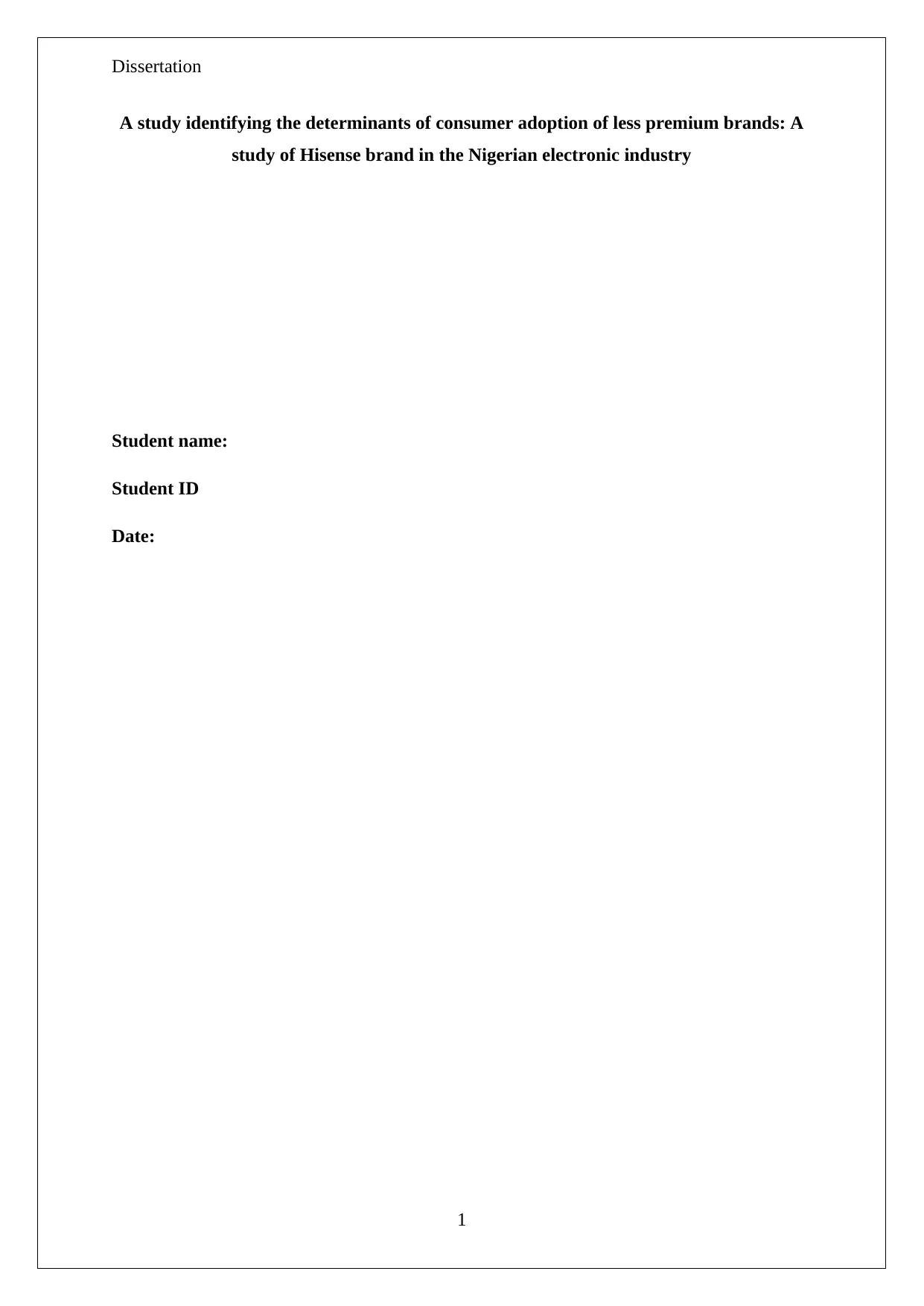
Dissertation
A study identifying the determinants of consumer adoption of less premium brands: A
study of Hisense brand in the Nigerian electronic industry
Student name:
Student ID
Date:
1
A study identifying the determinants of consumer adoption of less premium brands: A
study of Hisense brand in the Nigerian electronic industry
Student name:
Student ID
Date:
1
Secure Best Marks with AI Grader
Need help grading? Try our AI Grader for instant feedback on your assignments.

Dissertation
Abstract
The Nigerian consumer electronic goods market has been showing a great performance since
last decade even after the slowdown in 2018. The experts have marked foreign exchange
stability, rising Chinese electronic product influx and low inflation rate as the reasons for the
growth. Further, Nigeria marks an increase in the millennial population that strongly
contributes to the expansion of consumer electronic market as they crave advanced
technology to be the part of their lives. Hisense Co. Ltd. is a multinational company from
China producing and supplying electronic appliances worldwide. The Nigerian electronic
goods market is performing well with many luxury brands giving a tough time to the non-
premium brands like Hisense. The purpose of the study is to find out the determinants of
consumer adoption of such non-premium brands over luxury brands. The researcher has
applied primary method of data collection to find out the major determinants of consumer
adoption for less premium products in Nigerian context.
2
Abstract
The Nigerian consumer electronic goods market has been showing a great performance since
last decade even after the slowdown in 2018. The experts have marked foreign exchange
stability, rising Chinese electronic product influx and low inflation rate as the reasons for the
growth. Further, Nigeria marks an increase in the millennial population that strongly
contributes to the expansion of consumer electronic market as they crave advanced
technology to be the part of their lives. Hisense Co. Ltd. is a multinational company from
China producing and supplying electronic appliances worldwide. The Nigerian electronic
goods market is performing well with many luxury brands giving a tough time to the non-
premium brands like Hisense. The purpose of the study is to find out the determinants of
consumer adoption of such non-premium brands over luxury brands. The researcher has
applied primary method of data collection to find out the major determinants of consumer
adoption for less premium products in Nigerian context.
2
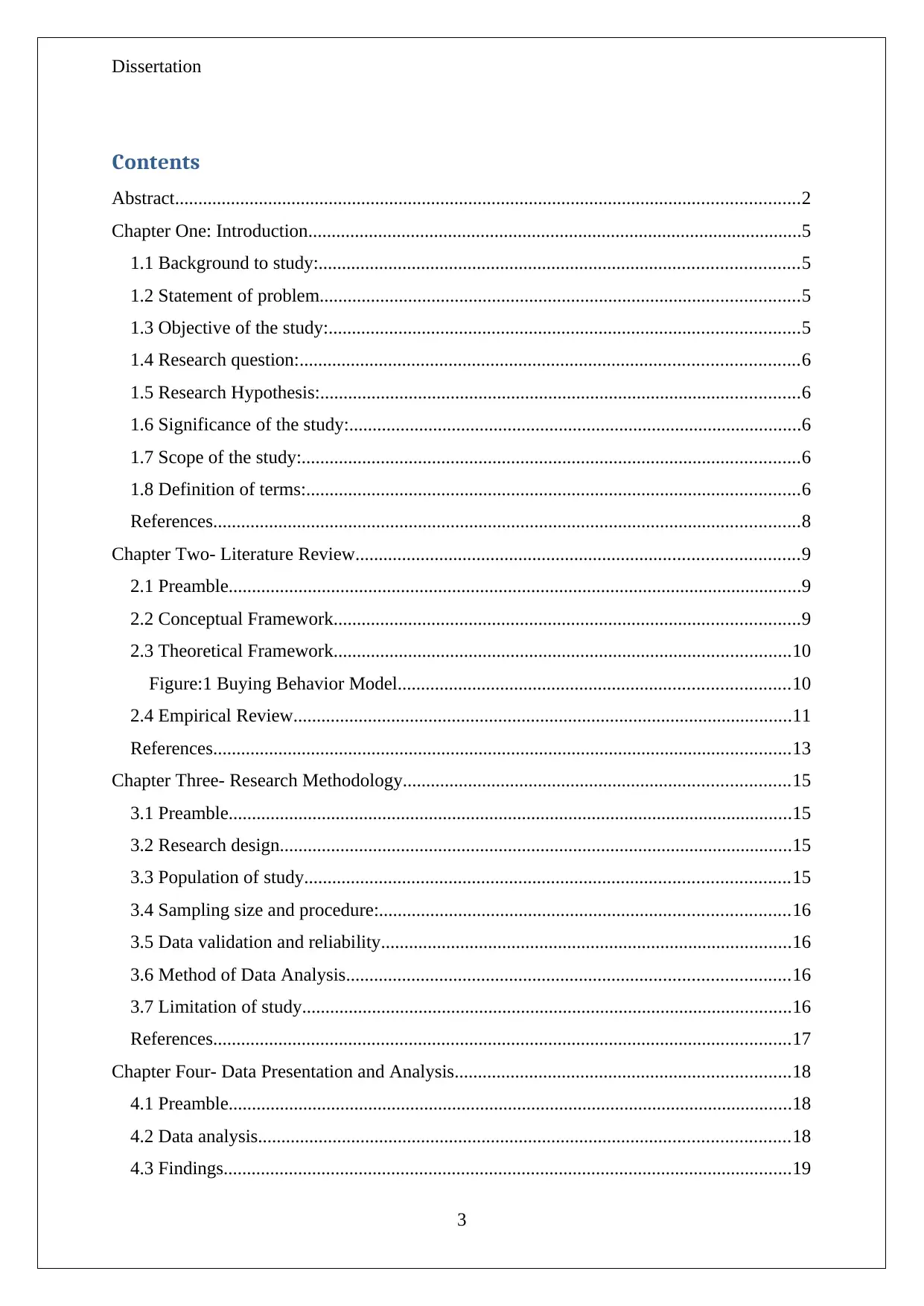
Dissertation
Contents
Abstract......................................................................................................................................2
Chapter One: Introduction..........................................................................................................5
1.1 Background to study:.......................................................................................................5
1.2 Statement of problem.......................................................................................................5
1.3 Objective of the study:.....................................................................................................5
1.4 Research question:...........................................................................................................6
1.5 Research Hypothesis:.......................................................................................................6
1.6 Significance of the study:.................................................................................................6
1.7 Scope of the study:...........................................................................................................6
1.8 Definition of terms:..........................................................................................................6
References..............................................................................................................................8
Chapter Two- Literature Review...............................................................................................9
2.1 Preamble...........................................................................................................................9
2.2 Conceptual Framework....................................................................................................9
2.3 Theoretical Framework..................................................................................................10
Figure:1 Buying Behavior Model....................................................................................10
2.4 Empirical Review...........................................................................................................11
References............................................................................................................................13
Chapter Three- Research Methodology...................................................................................15
3.1 Preamble.........................................................................................................................15
3.2 Research design..............................................................................................................15
3.3 Population of study........................................................................................................15
3.4 Sampling size and procedure:........................................................................................16
3.5 Data validation and reliability........................................................................................16
3.6 Method of Data Analysis...............................................................................................16
3.7 Limitation of study.........................................................................................................16
References............................................................................................................................17
Chapter Four- Data Presentation and Analysis........................................................................18
4.1 Preamble.........................................................................................................................18
4.2 Data analysis..................................................................................................................18
4.3 Findings..........................................................................................................................19
3
Contents
Abstract......................................................................................................................................2
Chapter One: Introduction..........................................................................................................5
1.1 Background to study:.......................................................................................................5
1.2 Statement of problem.......................................................................................................5
1.3 Objective of the study:.....................................................................................................5
1.4 Research question:...........................................................................................................6
1.5 Research Hypothesis:.......................................................................................................6
1.6 Significance of the study:.................................................................................................6
1.7 Scope of the study:...........................................................................................................6
1.8 Definition of terms:..........................................................................................................6
References..............................................................................................................................8
Chapter Two- Literature Review...............................................................................................9
2.1 Preamble...........................................................................................................................9
2.2 Conceptual Framework....................................................................................................9
2.3 Theoretical Framework..................................................................................................10
Figure:1 Buying Behavior Model....................................................................................10
2.4 Empirical Review...........................................................................................................11
References............................................................................................................................13
Chapter Three- Research Methodology...................................................................................15
3.1 Preamble.........................................................................................................................15
3.2 Research design..............................................................................................................15
3.3 Population of study........................................................................................................15
3.4 Sampling size and procedure:........................................................................................16
3.5 Data validation and reliability........................................................................................16
3.6 Method of Data Analysis...............................................................................................16
3.7 Limitation of study.........................................................................................................16
References............................................................................................................................17
Chapter Four- Data Presentation and Analysis........................................................................18
4.1 Preamble.........................................................................................................................18
4.2 Data analysis..................................................................................................................18
4.3 Findings..........................................................................................................................19
3

Dissertation
4.4 Test of Hypothesis..........................................................................................................20
References............................................................................................................................21
Chapter Five- Summary, Conclusion and Recommendation...................................................22
5.1 Summary........................................................................................................................22
5.2 Conclusion......................................................................................................................22
5.3 Recommendation............................................................................................................22
Bibliography.............................................................................................................................24
Appendix..................................................................................................................................27
4
4.4 Test of Hypothesis..........................................................................................................20
References............................................................................................................................21
Chapter Five- Summary, Conclusion and Recommendation...................................................22
5.1 Summary........................................................................................................................22
5.2 Conclusion......................................................................................................................22
5.3 Recommendation............................................................................................................22
Bibliography.............................................................................................................................24
Appendix..................................................................................................................................27
4
Secure Best Marks with AI Grader
Need help grading? Try our AI Grader for instant feedback on your assignments.
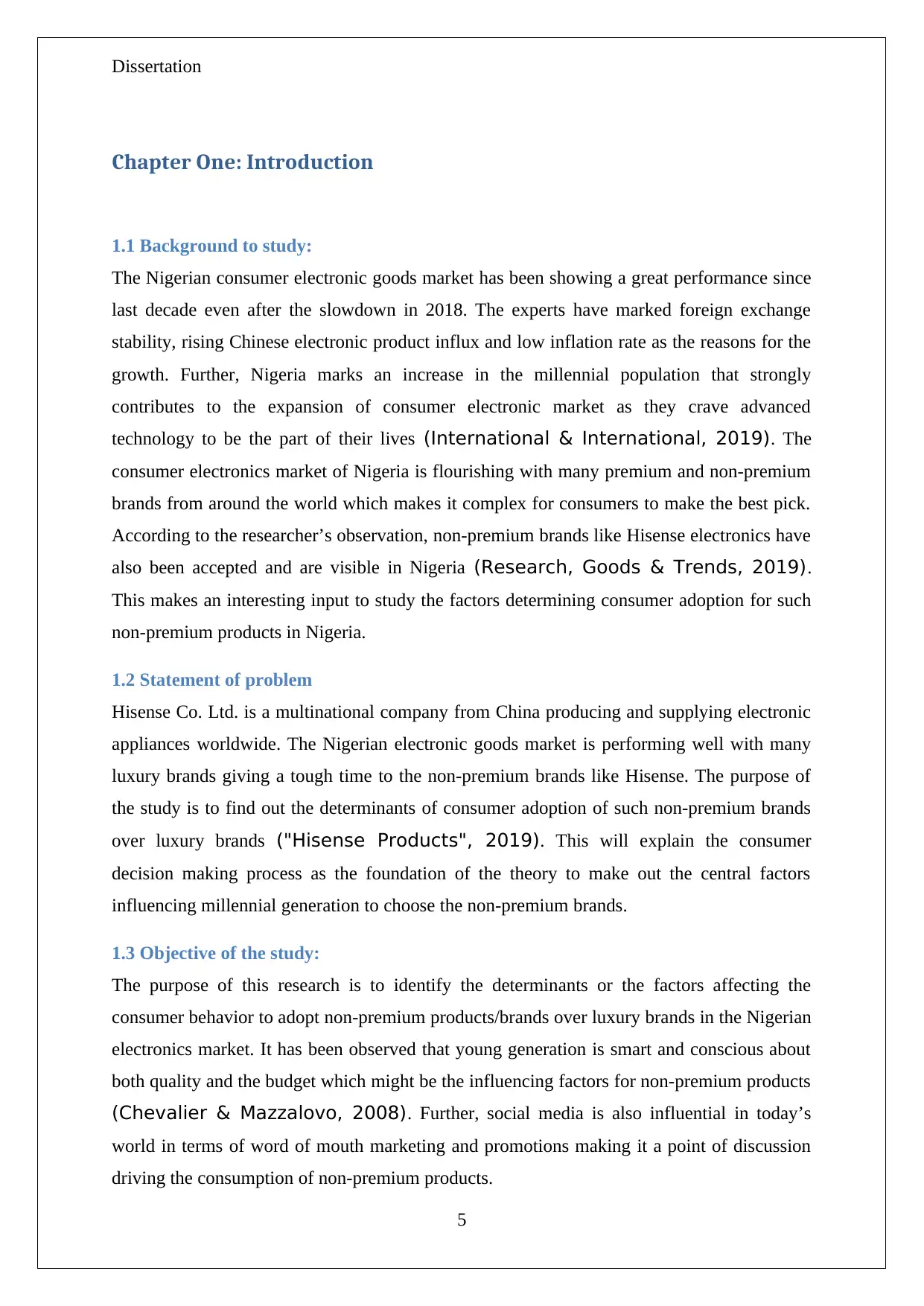
Dissertation
Chapter One: Introduction
1.1 Background to study:
The Nigerian consumer electronic goods market has been showing a great performance since
last decade even after the slowdown in 2018. The experts have marked foreign exchange
stability, rising Chinese electronic product influx and low inflation rate as the reasons for the
growth. Further, Nigeria marks an increase in the millennial population that strongly
contributes to the expansion of consumer electronic market as they crave advanced
technology to be the part of their lives (International & International, 2019). The
consumer electronics market of Nigeria is flourishing with many premium and non-premium
brands from around the world which makes it complex for consumers to make the best pick.
According to the researcher’s observation, non-premium brands like Hisense electronics have
also been accepted and are visible in Nigeria (Research, Goods & Trends, 2019).
This makes an interesting input to study the factors determining consumer adoption for such
non-premium products in Nigeria.
1.2 Statement of problem
Hisense Co. Ltd. is a multinational company from China producing and supplying electronic
appliances worldwide. The Nigerian electronic goods market is performing well with many
luxury brands giving a tough time to the non-premium brands like Hisense. The purpose of
the study is to find out the determinants of consumer adoption of such non-premium brands
over luxury brands ("Hisense Products", 2019). This will explain the consumer
decision making process as the foundation of the theory to make out the central factors
influencing millennial generation to choose the non-premium brands.
1.3 Objective of the study:
The purpose of this research is to identify the determinants or the factors affecting the
consumer behavior to adopt non-premium products/brands over luxury brands in the Nigerian
electronics market. It has been observed that young generation is smart and conscious about
both quality and the budget which might be the influencing factors for non-premium products
(Chevalier & Mazzalovo, 2008). Further, social media is also influential in today’s
world in terms of word of mouth marketing and promotions making it a point of discussion
driving the consumption of non-premium products.
5
Chapter One: Introduction
1.1 Background to study:
The Nigerian consumer electronic goods market has been showing a great performance since
last decade even after the slowdown in 2018. The experts have marked foreign exchange
stability, rising Chinese electronic product influx and low inflation rate as the reasons for the
growth. Further, Nigeria marks an increase in the millennial population that strongly
contributes to the expansion of consumer electronic market as they crave advanced
technology to be the part of their lives (International & International, 2019). The
consumer electronics market of Nigeria is flourishing with many premium and non-premium
brands from around the world which makes it complex for consumers to make the best pick.
According to the researcher’s observation, non-premium brands like Hisense electronics have
also been accepted and are visible in Nigeria (Research, Goods & Trends, 2019).
This makes an interesting input to study the factors determining consumer adoption for such
non-premium products in Nigeria.
1.2 Statement of problem
Hisense Co. Ltd. is a multinational company from China producing and supplying electronic
appliances worldwide. The Nigerian electronic goods market is performing well with many
luxury brands giving a tough time to the non-premium brands like Hisense. The purpose of
the study is to find out the determinants of consumer adoption of such non-premium brands
over luxury brands ("Hisense Products", 2019). This will explain the consumer
decision making process as the foundation of the theory to make out the central factors
influencing millennial generation to choose the non-premium brands.
1.3 Objective of the study:
The purpose of this research is to identify the determinants or the factors affecting the
consumer behavior to adopt non-premium products/brands over luxury brands in the Nigerian
electronics market. It has been observed that young generation is smart and conscious about
both quality and the budget which might be the influencing factors for non-premium products
(Chevalier & Mazzalovo, 2008). Further, social media is also influential in today’s
world in terms of word of mouth marketing and promotions making it a point of discussion
driving the consumption of non-premium products.
5
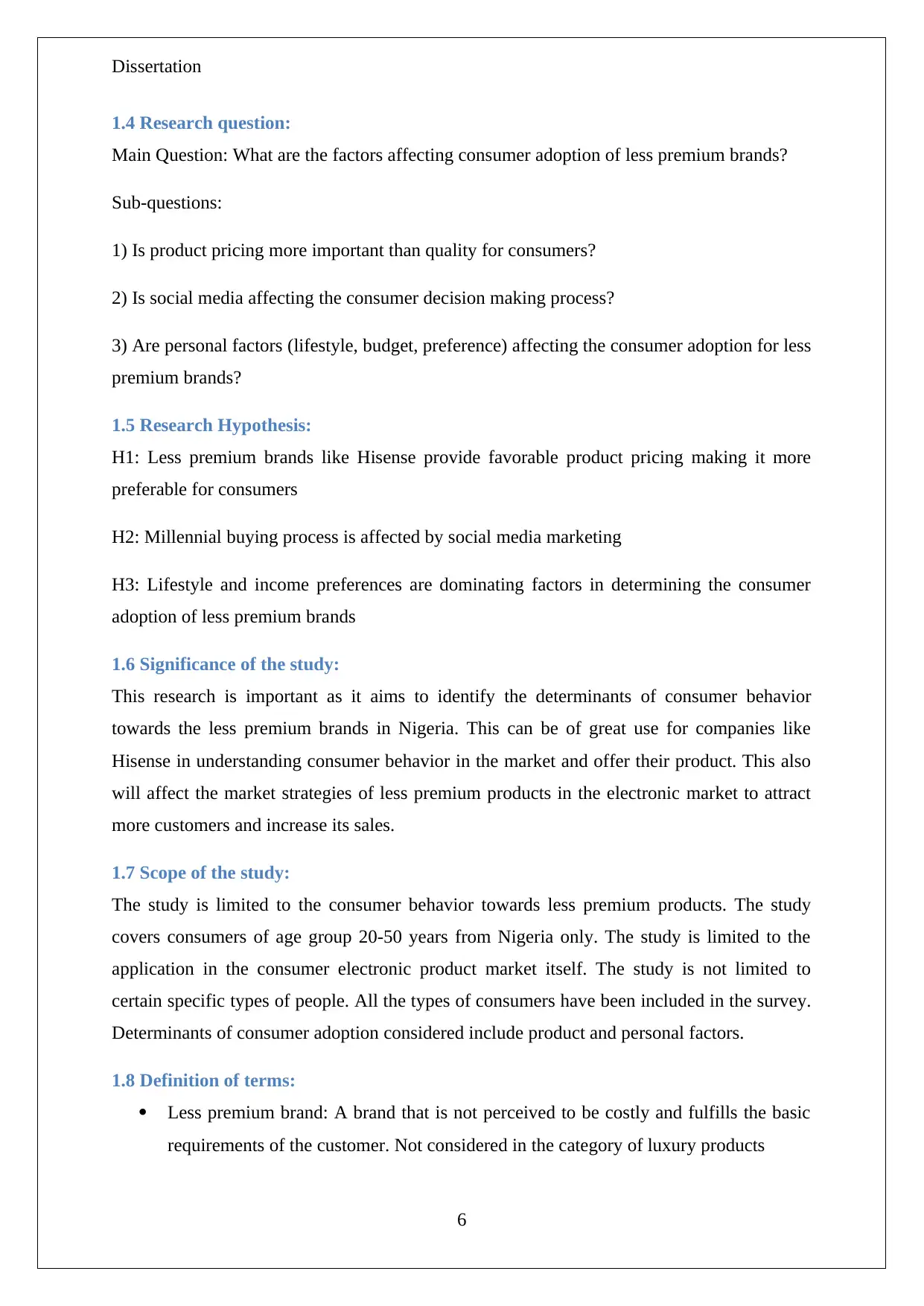
Dissertation
1.4 Research question:
Main Question: What are the factors affecting consumer adoption of less premium brands?
Sub-questions:
1) Is product pricing more important than quality for consumers?
2) Is social media affecting the consumer decision making process?
3) Are personal factors (lifestyle, budget, preference) affecting the consumer adoption for less
premium brands?
1.5 Research Hypothesis:
H1: Less premium brands like Hisense provide favorable product pricing making it more
preferable for consumers
H2: Millennial buying process is affected by social media marketing
H3: Lifestyle and income preferences are dominating factors in determining the consumer
adoption of less premium brands
1.6 Significance of the study:
This research is important as it aims to identify the determinants of consumer behavior
towards the less premium brands in Nigeria. This can be of great use for companies like
Hisense in understanding consumer behavior in the market and offer their product. This also
will affect the market strategies of less premium products in the electronic market to attract
more customers and increase its sales.
1.7 Scope of the study:
The study is limited to the consumer behavior towards less premium products. The study
covers consumers of age group 20-50 years from Nigeria only. The study is limited to the
application in the consumer electronic product market itself. The study is not limited to
certain specific types of people. All the types of consumers have been included in the survey.
Determinants of consumer adoption considered include product and personal factors.
1.8 Definition of terms:
Less premium brand: A brand that is not perceived to be costly and fulfills the basic
requirements of the customer. Not considered in the category of luxury products
6
1.4 Research question:
Main Question: What are the factors affecting consumer adoption of less premium brands?
Sub-questions:
1) Is product pricing more important than quality for consumers?
2) Is social media affecting the consumer decision making process?
3) Are personal factors (lifestyle, budget, preference) affecting the consumer adoption for less
premium brands?
1.5 Research Hypothesis:
H1: Less premium brands like Hisense provide favorable product pricing making it more
preferable for consumers
H2: Millennial buying process is affected by social media marketing
H3: Lifestyle and income preferences are dominating factors in determining the consumer
adoption of less premium brands
1.6 Significance of the study:
This research is important as it aims to identify the determinants of consumer behavior
towards the less premium brands in Nigeria. This can be of great use for companies like
Hisense in understanding consumer behavior in the market and offer their product. This also
will affect the market strategies of less premium products in the electronic market to attract
more customers and increase its sales.
1.7 Scope of the study:
The study is limited to the consumer behavior towards less premium products. The study
covers consumers of age group 20-50 years from Nigeria only. The study is limited to the
application in the consumer electronic product market itself. The study is not limited to
certain specific types of people. All the types of consumers have been included in the survey.
Determinants of consumer adoption considered include product and personal factors.
1.8 Definition of terms:
Less premium brand: A brand that is not perceived to be costly and fulfills the basic
requirements of the customer. Not considered in the category of luxury products
6
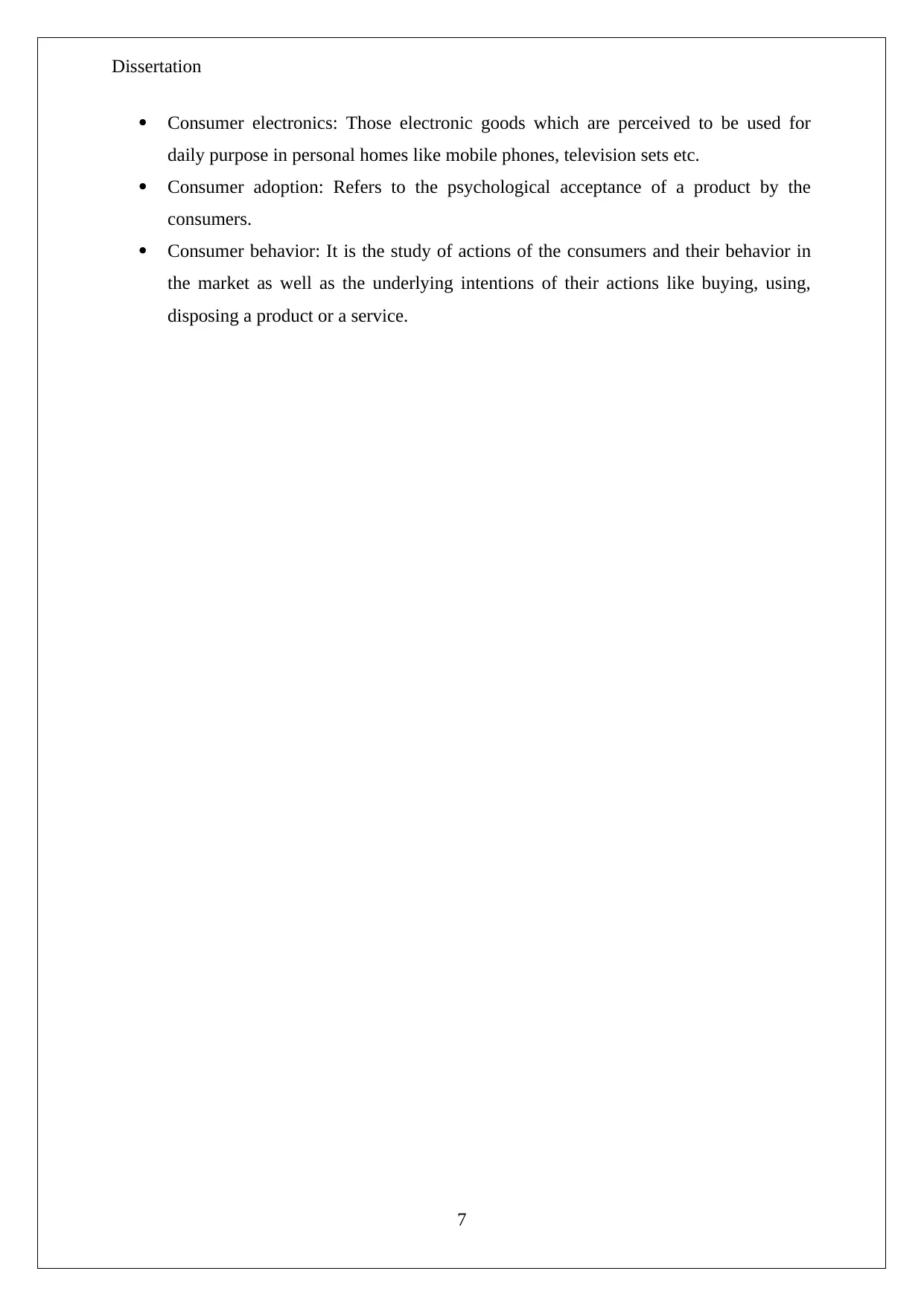
Dissertation
Consumer electronics: Those electronic goods which are perceived to be used for
daily purpose in personal homes like mobile phones, television sets etc.
Consumer adoption: Refers to the psychological acceptance of a product by the
consumers.
Consumer behavior: It is the study of actions of the consumers and their behavior in
the market as well as the underlying intentions of their actions like buying, using,
disposing a product or a service.
7
Consumer electronics: Those electronic goods which are perceived to be used for
daily purpose in personal homes like mobile phones, television sets etc.
Consumer adoption: Refers to the psychological acceptance of a product by the
consumers.
Consumer behavior: It is the study of actions of the consumers and their behavior in
the market as well as the underlying intentions of their actions like buying, using,
disposing a product or a service.
7
Paraphrase This Document
Need a fresh take? Get an instant paraphrase of this document with our AI Paraphraser
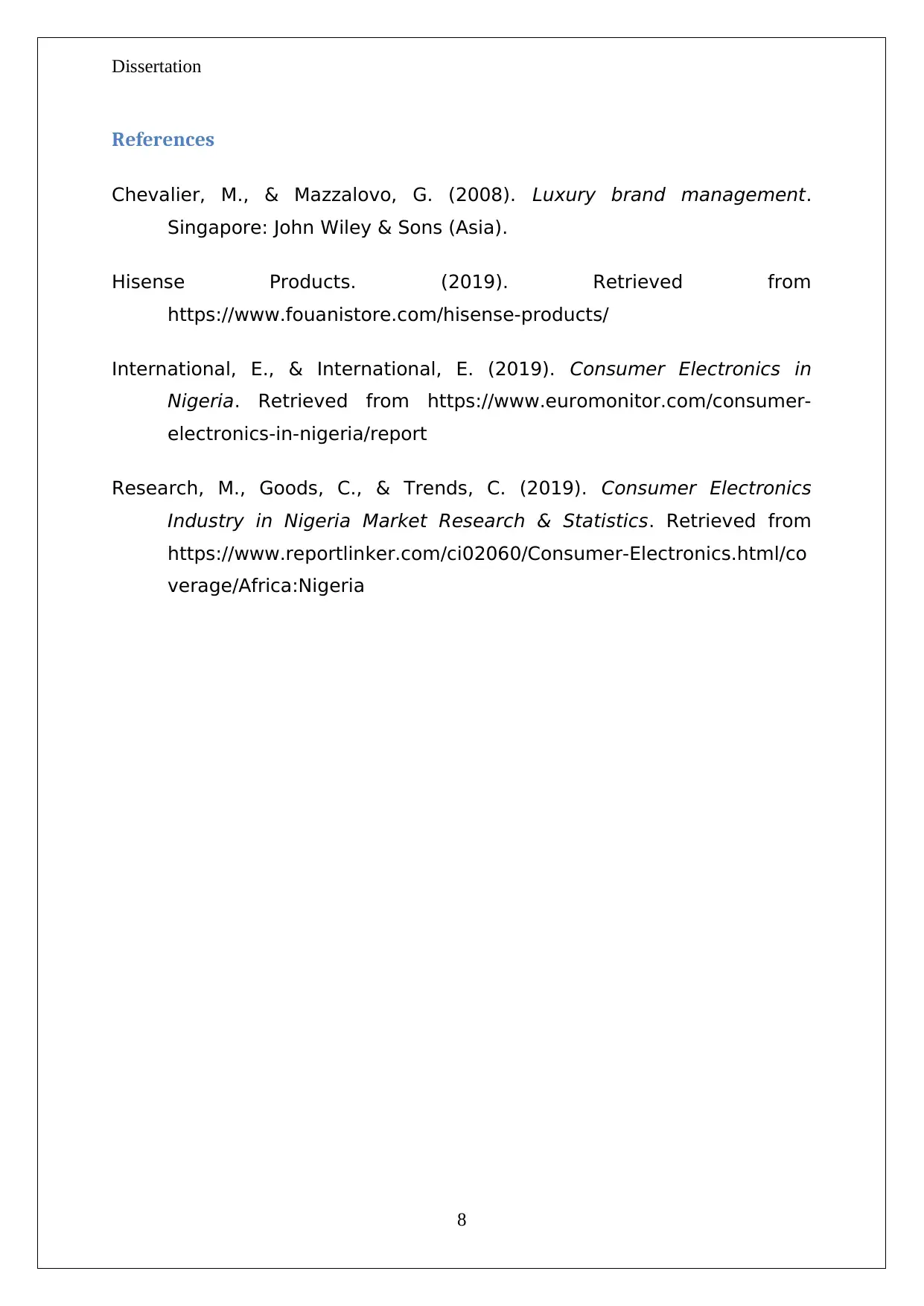
Dissertation
References
Chevalier, M., & Mazzalovo, G. (2008). Luxury brand management.
Singapore: John Wiley & Sons (Asia).
Hisense Products. (2019). Retrieved from
https://www.fouanistore.com/hisense-products/
International, E., & International, E. (2019). Consumer Electronics in
Nigeria. Retrieved from https://www.euromonitor.com/consumer-
electronics-in-nigeria/report
Research, M., Goods, C., & Trends, C. (2019). Consumer Electronics
Industry in Nigeria Market Research & Statistics. Retrieved from
https://www.reportlinker.com/ci02060/Consumer-Electronics.html/co
verage/Africa:Nigeria
8
References
Chevalier, M., & Mazzalovo, G. (2008). Luxury brand management.
Singapore: John Wiley & Sons (Asia).
Hisense Products. (2019). Retrieved from
https://www.fouanistore.com/hisense-products/
International, E., & International, E. (2019). Consumer Electronics in
Nigeria. Retrieved from https://www.euromonitor.com/consumer-
electronics-in-nigeria/report
Research, M., Goods, C., & Trends, C. (2019). Consumer Electronics
Industry in Nigeria Market Research & Statistics. Retrieved from
https://www.reportlinker.com/ci02060/Consumer-Electronics.html/co
verage/Africa:Nigeria
8
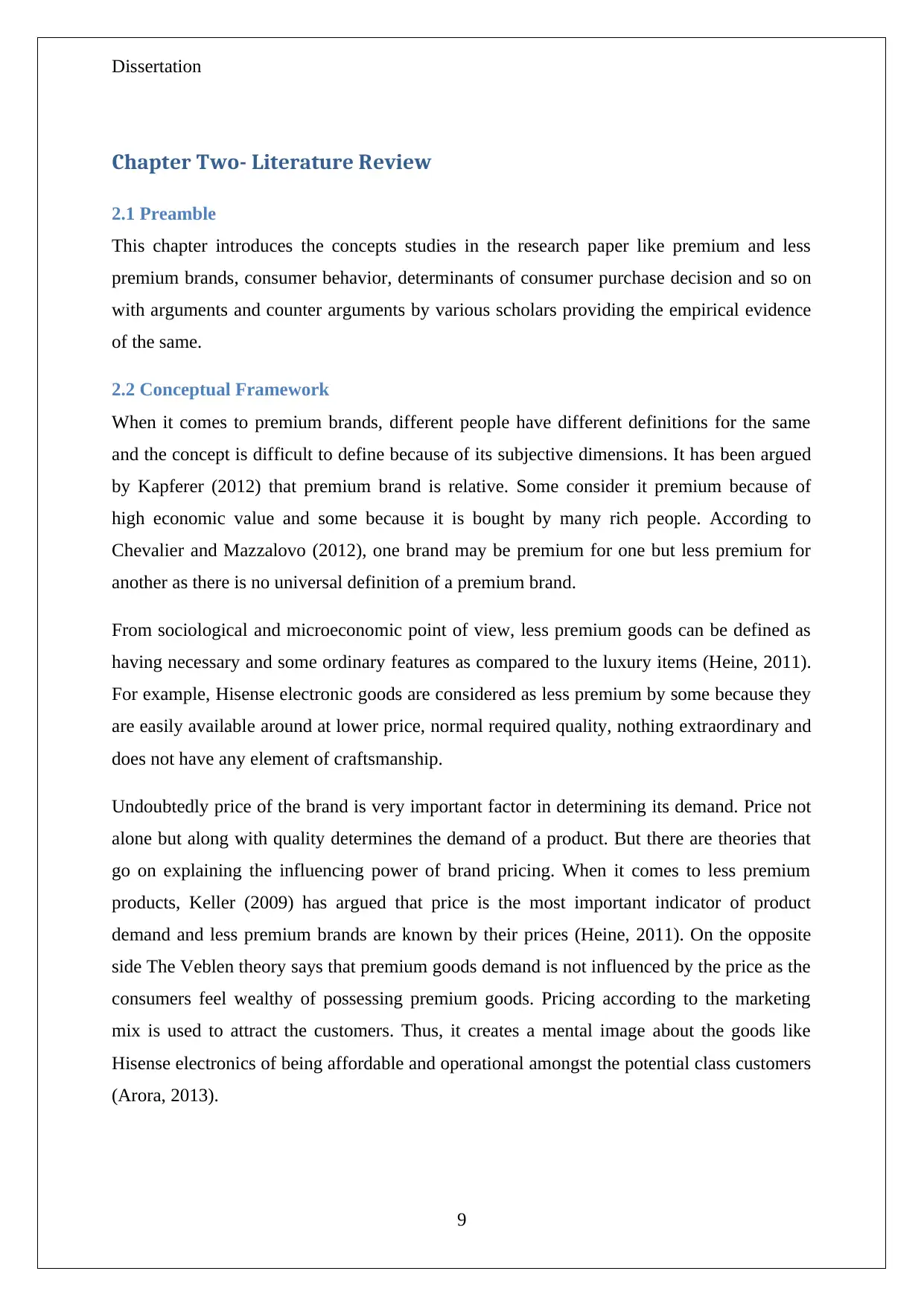
Dissertation
Chapter Two- Literature Review
2.1 Preamble
This chapter introduces the concepts studies in the research paper like premium and less
premium brands, consumer behavior, determinants of consumer purchase decision and so on
with arguments and counter arguments by various scholars providing the empirical evidence
of the same.
2.2 Conceptual Framework
When it comes to premium brands, different people have different definitions for the same
and the concept is difficult to define because of its subjective dimensions. It has been argued
by Kapferer (2012) that premium brand is relative. Some consider it premium because of
high economic value and some because it is bought by many rich people. According to
Chevalier and Mazzalovo (2012), one brand may be premium for one but less premium for
another as there is no universal definition of a premium brand.
From sociological and microeconomic point of view, less premium goods can be defined as
having necessary and some ordinary features as compared to the luxury items (Heine, 2011).
For example, Hisense electronic goods are considered as less premium by some because they
are easily available around at lower price, normal required quality, nothing extraordinary and
does not have any element of craftsmanship.
Undoubtedly price of the brand is very important factor in determining its demand. Price not
alone but along with quality determines the demand of a product. But there are theories that
go on explaining the influencing power of brand pricing. When it comes to less premium
products, Keller (2009) has argued that price is the most important indicator of product
demand and less premium brands are known by their prices (Heine, 2011). On the opposite
side The Veblen theory says that premium goods demand is not influenced by the price as the
consumers feel wealthy of possessing premium goods. Pricing according to the marketing
mix is used to attract the customers. Thus, it creates a mental image about the goods like
Hisense electronics of being affordable and operational amongst the potential class customers
(Arora, 2013).
9
Chapter Two- Literature Review
2.1 Preamble
This chapter introduces the concepts studies in the research paper like premium and less
premium brands, consumer behavior, determinants of consumer purchase decision and so on
with arguments and counter arguments by various scholars providing the empirical evidence
of the same.
2.2 Conceptual Framework
When it comes to premium brands, different people have different definitions for the same
and the concept is difficult to define because of its subjective dimensions. It has been argued
by Kapferer (2012) that premium brand is relative. Some consider it premium because of
high economic value and some because it is bought by many rich people. According to
Chevalier and Mazzalovo (2012), one brand may be premium for one but less premium for
another as there is no universal definition of a premium brand.
From sociological and microeconomic point of view, less premium goods can be defined as
having necessary and some ordinary features as compared to the luxury items (Heine, 2011).
For example, Hisense electronic goods are considered as less premium by some because they
are easily available around at lower price, normal required quality, nothing extraordinary and
does not have any element of craftsmanship.
Undoubtedly price of the brand is very important factor in determining its demand. Price not
alone but along with quality determines the demand of a product. But there are theories that
go on explaining the influencing power of brand pricing. When it comes to less premium
products, Keller (2009) has argued that price is the most important indicator of product
demand and less premium brands are known by their prices (Heine, 2011). On the opposite
side The Veblen theory says that premium goods demand is not influenced by the price as the
consumers feel wealthy of possessing premium goods. Pricing according to the marketing
mix is used to attract the customers. Thus, it creates a mental image about the goods like
Hisense electronics of being affordable and operational amongst the potential class customers
(Arora, 2013).
9
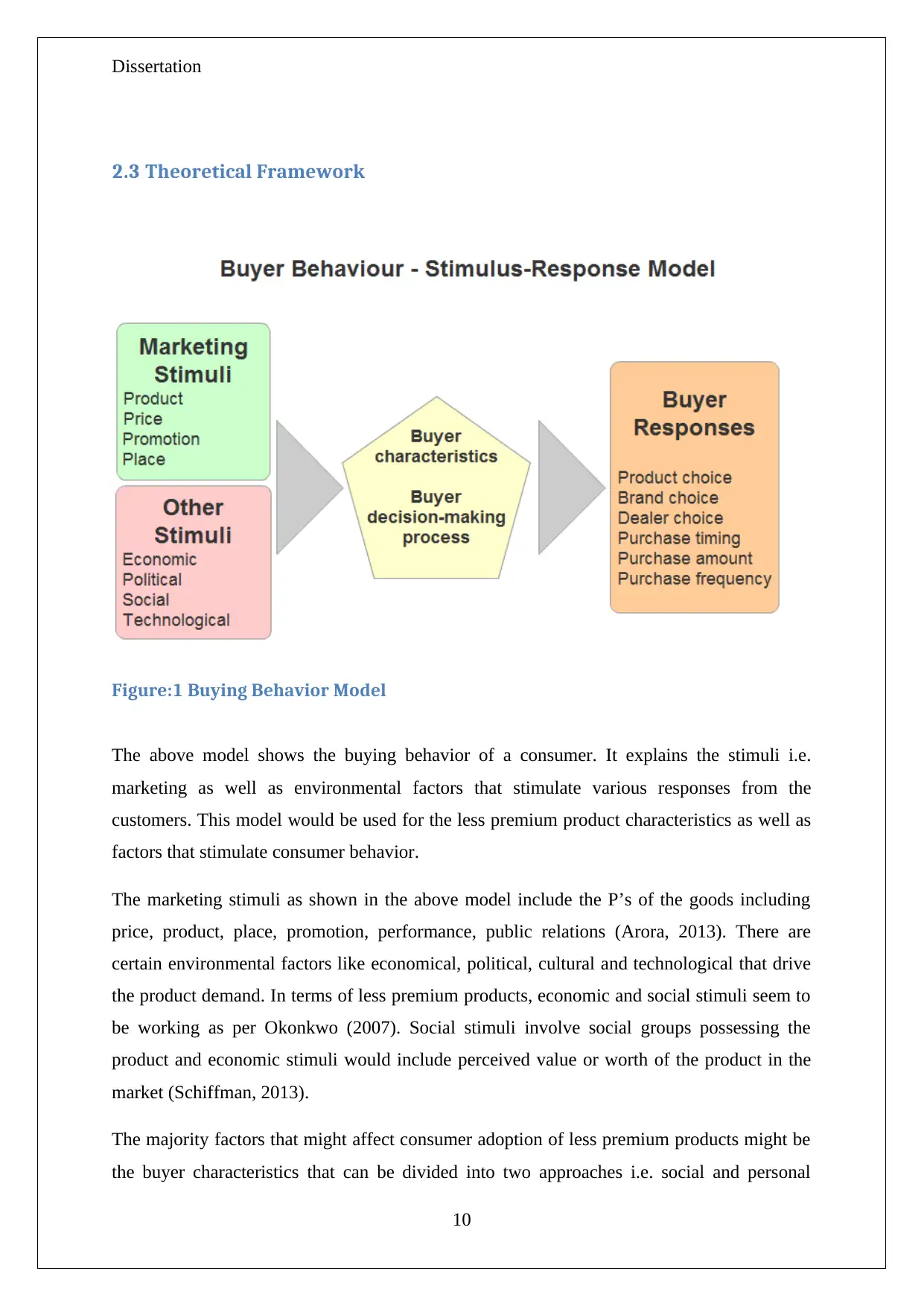
Dissertation
2.3 Theoretical Framework
Figure:1 Buying Behavior Model
The above model shows the buying behavior of a consumer. It explains the stimuli i.e.
marketing as well as environmental factors that stimulate various responses from the
customers. This model would be used for the less premium product characteristics as well as
factors that stimulate consumer behavior.
The marketing stimuli as shown in the above model include the P’s of the goods including
price, product, place, promotion, performance, public relations (Arora, 2013). There are
certain environmental factors like economical, political, cultural and technological that drive
the product demand. In terms of less premium products, economic and social stimuli seem to
be working as per Okonkwo (2007). Social stimuli involve social groups possessing the
product and economic stimuli would include perceived value or worth of the product in the
market (Schiffman, 2013).
The majority factors that might affect consumer adoption of less premium products might be
the buyer characteristics that can be divided into two approaches i.e. social and personal
10
2.3 Theoretical Framework
Figure:1 Buying Behavior Model
The above model shows the buying behavior of a consumer. It explains the stimuli i.e.
marketing as well as environmental factors that stimulate various responses from the
customers. This model would be used for the less premium product characteristics as well as
factors that stimulate consumer behavior.
The marketing stimuli as shown in the above model include the P’s of the goods including
price, product, place, promotion, performance, public relations (Arora, 2013). There are
certain environmental factors like economical, political, cultural and technological that drive
the product demand. In terms of less premium products, economic and social stimuli seem to
be working as per Okonkwo (2007). Social stimuli involve social groups possessing the
product and economic stimuli would include perceived value or worth of the product in the
market (Schiffman, 2013).
The majority factors that might affect consumer adoption of less premium products might be
the buyer characteristics that can be divided into two approaches i.e. social and personal
10
Secure Best Marks with AI Grader
Need help grading? Try our AI Grader for instant feedback on your assignments.
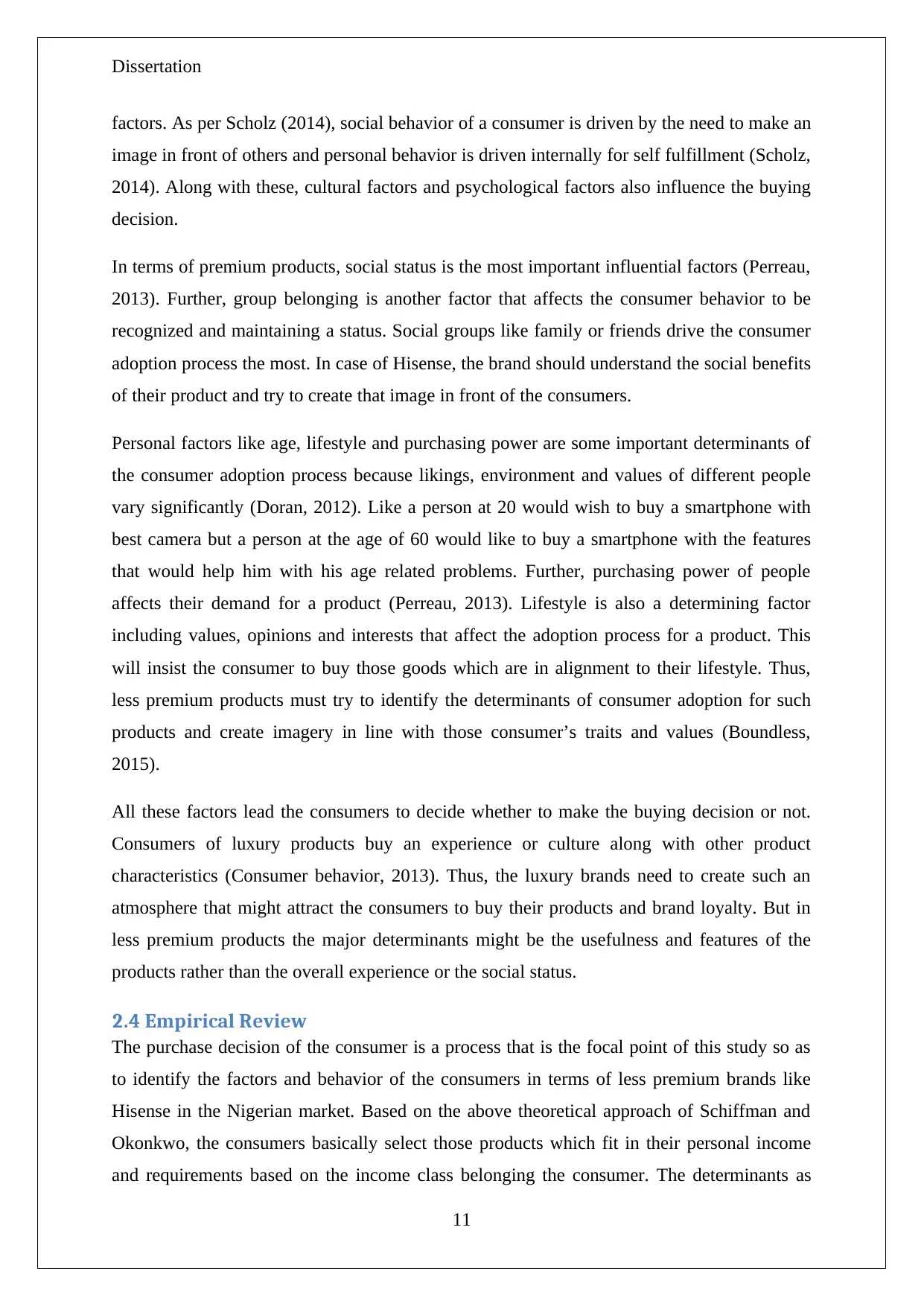
Dissertation
factors. As per Scholz (2014), social behavior of a consumer is driven by the need to make an
image in front of others and personal behavior is driven internally for self fulfillment (Scholz,
2014). Along with these, cultural factors and psychological factors also influence the buying
decision.
In terms of premium products, social status is the most important influential factors (Perreau,
2013). Further, group belonging is another factor that affects the consumer behavior to be
recognized and maintaining a status. Social groups like family or friends drive the consumer
adoption process the most. In case of Hisense, the brand should understand the social benefits
of their product and try to create that image in front of the consumers.
Personal factors like age, lifestyle and purchasing power are some important determinants of
the consumer adoption process because likings, environment and values of different people
vary significantly (Doran, 2012). Like a person at 20 would wish to buy a smartphone with
best camera but a person at the age of 60 would like to buy a smartphone with the features
that would help him with his age related problems. Further, purchasing power of people
affects their demand for a product (Perreau, 2013). Lifestyle is also a determining factor
including values, opinions and interests that affect the adoption process for a product. This
will insist the consumer to buy those goods which are in alignment to their lifestyle. Thus,
less premium products must try to identify the determinants of consumer adoption for such
products and create imagery in line with those consumer’s traits and values (Boundless,
2015).
All these factors lead the consumers to decide whether to make the buying decision or not.
Consumers of luxury products buy an experience or culture along with other product
characteristics (Consumer behavior, 2013). Thus, the luxury brands need to create such an
atmosphere that might attract the consumers to buy their products and brand loyalty. But in
less premium products the major determinants might be the usefulness and features of the
products rather than the overall experience or the social status.
2.4 Empirical Review
The purchase decision of the consumer is a process that is the focal point of this study so as
to identify the factors and behavior of the consumers in terms of less premium brands like
Hisense in the Nigerian market. Based on the above theoretical approach of Schiffman and
Okonkwo, the consumers basically select those products which fit in their personal income
and requirements based on the income class belonging the consumer. The determinants as
11
factors. As per Scholz (2014), social behavior of a consumer is driven by the need to make an
image in front of others and personal behavior is driven internally for self fulfillment (Scholz,
2014). Along with these, cultural factors and psychological factors also influence the buying
decision.
In terms of premium products, social status is the most important influential factors (Perreau,
2013). Further, group belonging is another factor that affects the consumer behavior to be
recognized and maintaining a status. Social groups like family or friends drive the consumer
adoption process the most. In case of Hisense, the brand should understand the social benefits
of their product and try to create that image in front of the consumers.
Personal factors like age, lifestyle and purchasing power are some important determinants of
the consumer adoption process because likings, environment and values of different people
vary significantly (Doran, 2012). Like a person at 20 would wish to buy a smartphone with
best camera but a person at the age of 60 would like to buy a smartphone with the features
that would help him with his age related problems. Further, purchasing power of people
affects their demand for a product (Perreau, 2013). Lifestyle is also a determining factor
including values, opinions and interests that affect the adoption process for a product. This
will insist the consumer to buy those goods which are in alignment to their lifestyle. Thus,
less premium products must try to identify the determinants of consumer adoption for such
products and create imagery in line with those consumer’s traits and values (Boundless,
2015).
All these factors lead the consumers to decide whether to make the buying decision or not.
Consumers of luxury products buy an experience or culture along with other product
characteristics (Consumer behavior, 2013). Thus, the luxury brands need to create such an
atmosphere that might attract the consumers to buy their products and brand loyalty. But in
less premium products the major determinants might be the usefulness and features of the
products rather than the overall experience or the social status.
2.4 Empirical Review
The purchase decision of the consumer is a process that is the focal point of this study so as
to identify the factors and behavior of the consumers in terms of less premium brands like
Hisense in the Nigerian market. Based on the above theoretical approach of Schiffman and
Okonkwo, the consumers basically select those products which fit in their personal income
and requirements based on the income class belonging the consumer. The determinants as
11

Dissertation
evident from the studies include personal factors, perceived economic factors, marketing mix
of the brand and external environment.
12
evident from the studies include personal factors, perceived economic factors, marketing mix
of the brand and external environment.
12
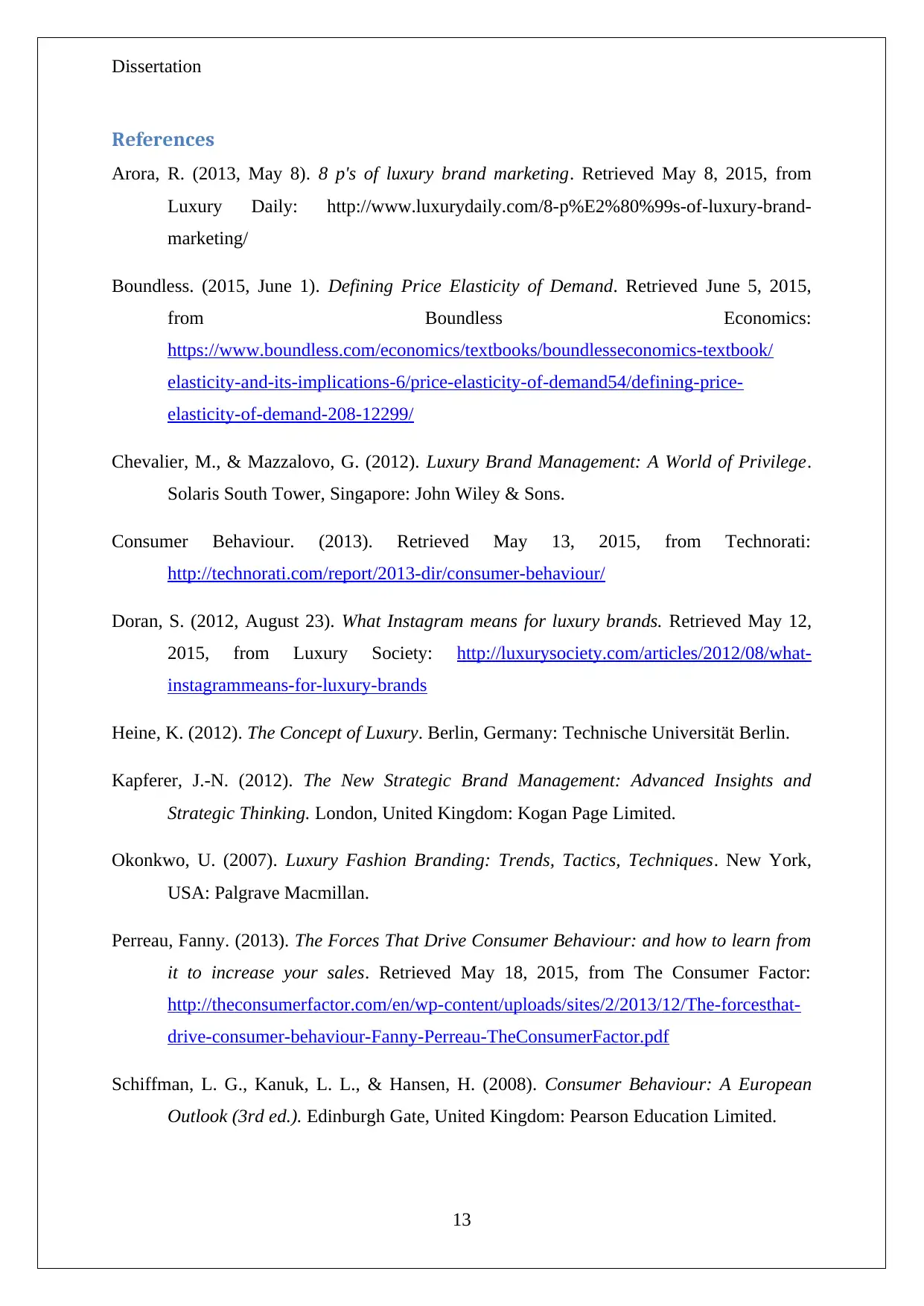
Dissertation
References
Arora, R. (2013, May 8). 8 p's of luxury brand marketing. Retrieved May 8, 2015, from
Luxury Daily: http://www.luxurydaily.com/8-p%E2%80%99s-of-luxury-brand-
marketing/
Boundless. (2015, June 1). Defining Price Elasticity of Demand. Retrieved June 5, 2015,
from Boundless Economics:
https://www.boundless.com/economics/textbooks/boundlesseconomics-textbook/
elasticity-and-its-implications-6/price-elasticity-of-demand54/defining-price-
elasticity-of-demand-208-12299/
Chevalier, M., & Mazzalovo, G. (2012). Luxury Brand Management: A World of Privilege.
Solaris South Tower, Singapore: John Wiley & Sons.
Consumer Behaviour. (2013). Retrieved May 13, 2015, from Technorati:
http://technorati.com/report/2013-dir/consumer-behaviour/
Doran, S. (2012, August 23). What Instagram means for luxury brands. Retrieved May 12,
2015, from Luxury Society: http://luxurysociety.com/articles/2012/08/what-
instagrammeans-for-luxury-brands
Heine, K. (2012). The Concept of Luxury. Berlin, Germany: Technische Universität Berlin.
Kapferer, J.-N. (2012). The New Strategic Brand Management: Advanced Insights and
Strategic Thinking. London, United Kingdom: Kogan Page Limited.
Okonkwo, U. (2007). Luxury Fashion Branding: Trends, Tactics, Techniques. New York,
USA: Palgrave Macmillan.
Perreau, Fanny. (2013). The Forces That Drive Consumer Behaviour: and how to learn from
it to increase your sales. Retrieved May 18, 2015, from The Consumer Factor:
http://theconsumerfactor.com/en/wp-content/uploads/sites/2/2013/12/The-forcesthat-
drive-consumer-behaviour-Fanny-Perreau-TheConsumerFactor.pdf
Schiffman, L. G., Kanuk, L. L., & Hansen, H. (2008). Consumer Behaviour: A European
Outlook (3rd ed.). Edinburgh Gate, United Kingdom: Pearson Education Limited.
13
References
Arora, R. (2013, May 8). 8 p's of luxury brand marketing. Retrieved May 8, 2015, from
Luxury Daily: http://www.luxurydaily.com/8-p%E2%80%99s-of-luxury-brand-
marketing/
Boundless. (2015, June 1). Defining Price Elasticity of Demand. Retrieved June 5, 2015,
from Boundless Economics:
https://www.boundless.com/economics/textbooks/boundlesseconomics-textbook/
elasticity-and-its-implications-6/price-elasticity-of-demand54/defining-price-
elasticity-of-demand-208-12299/
Chevalier, M., & Mazzalovo, G. (2012). Luxury Brand Management: A World of Privilege.
Solaris South Tower, Singapore: John Wiley & Sons.
Consumer Behaviour. (2013). Retrieved May 13, 2015, from Technorati:
http://technorati.com/report/2013-dir/consumer-behaviour/
Doran, S. (2012, August 23). What Instagram means for luxury brands. Retrieved May 12,
2015, from Luxury Society: http://luxurysociety.com/articles/2012/08/what-
instagrammeans-for-luxury-brands
Heine, K. (2012). The Concept of Luxury. Berlin, Germany: Technische Universität Berlin.
Kapferer, J.-N. (2012). The New Strategic Brand Management: Advanced Insights and
Strategic Thinking. London, United Kingdom: Kogan Page Limited.
Okonkwo, U. (2007). Luxury Fashion Branding: Trends, Tactics, Techniques. New York,
USA: Palgrave Macmillan.
Perreau, Fanny. (2013). The Forces That Drive Consumer Behaviour: and how to learn from
it to increase your sales. Retrieved May 18, 2015, from The Consumer Factor:
http://theconsumerfactor.com/en/wp-content/uploads/sites/2/2013/12/The-forcesthat-
drive-consumer-behaviour-Fanny-Perreau-TheConsumerFactor.pdf
Schiffman, L. G., Kanuk, L. L., & Hansen, H. (2008). Consumer Behaviour: A European
Outlook (3rd ed.). Edinburgh Gate, United Kingdom: Pearson Education Limited.
13
Paraphrase This Document
Need a fresh take? Get an instant paraphrase of this document with our AI Paraphraser

Dissertation
Scholz, L. M. (2014). Brand Management and Marketing of Luxury Goods. Hamburg,
Germany: Anchor Academic Publishing.
14
Scholz, L. M. (2014). Brand Management and Marketing of Luxury Goods. Hamburg,
Germany: Anchor Academic Publishing.
14
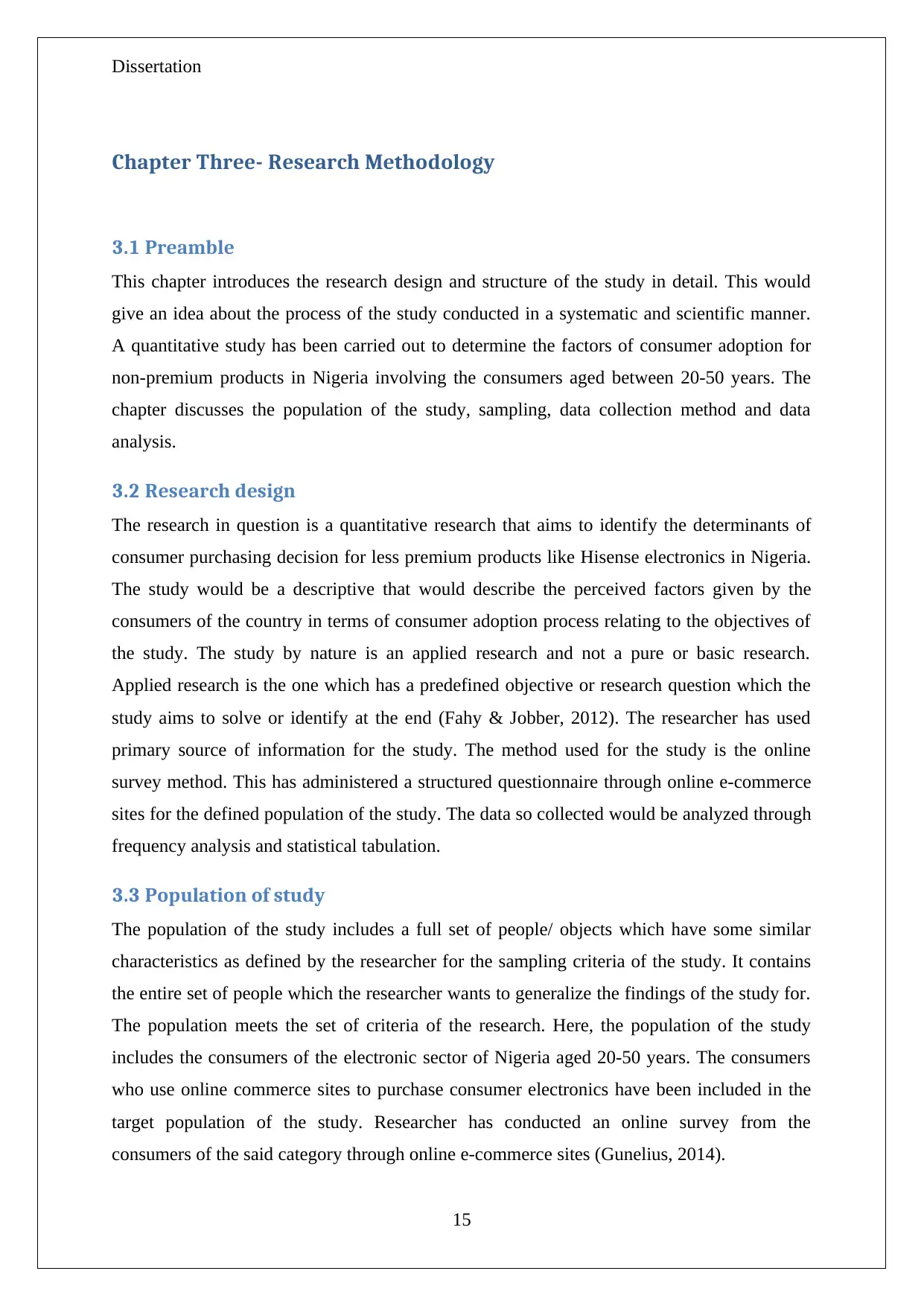
Dissertation
Chapter Three- Research Methodology
3.1 Preamble
This chapter introduces the research design and structure of the study in detail. This would
give an idea about the process of the study conducted in a systematic and scientific manner.
A quantitative study has been carried out to determine the factors of consumer adoption for
non-premium products in Nigeria involving the consumers aged between 20-50 years. The
chapter discusses the population of the study, sampling, data collection method and data
analysis.
3.2 Research design
The research in question is a quantitative research that aims to identify the determinants of
consumer purchasing decision for less premium products like Hisense electronics in Nigeria.
The study would be a descriptive that would describe the perceived factors given by the
consumers of the country in terms of consumer adoption process relating to the objectives of
the study. The study by nature is an applied research and not a pure or basic research.
Applied research is the one which has a predefined objective or research question which the
study aims to solve or identify at the end (Fahy & Jobber, 2012). The researcher has used
primary source of information for the study. The method used for the study is the online
survey method. This has administered a structured questionnaire through online e-commerce
sites for the defined population of the study. The data so collected would be analyzed through
frequency analysis and statistical tabulation.
3.3 Population of study
The population of the study includes a full set of people/ objects which have some similar
characteristics as defined by the researcher for the sampling criteria of the study. It contains
the entire set of people which the researcher wants to generalize the findings of the study for.
The population meets the set of criteria of the research. Here, the population of the study
includes the consumers of the electronic sector of Nigeria aged 20-50 years. The consumers
who use online commerce sites to purchase consumer electronics have been included in the
target population of the study. Researcher has conducted an online survey from the
consumers of the said category through online e-commerce sites (Gunelius, 2014).
15
Chapter Three- Research Methodology
3.1 Preamble
This chapter introduces the research design and structure of the study in detail. This would
give an idea about the process of the study conducted in a systematic and scientific manner.
A quantitative study has been carried out to determine the factors of consumer adoption for
non-premium products in Nigeria involving the consumers aged between 20-50 years. The
chapter discusses the population of the study, sampling, data collection method and data
analysis.
3.2 Research design
The research in question is a quantitative research that aims to identify the determinants of
consumer purchasing decision for less premium products like Hisense electronics in Nigeria.
The study would be a descriptive that would describe the perceived factors given by the
consumers of the country in terms of consumer adoption process relating to the objectives of
the study. The study by nature is an applied research and not a pure or basic research.
Applied research is the one which has a predefined objective or research question which the
study aims to solve or identify at the end (Fahy & Jobber, 2012). The researcher has used
primary source of information for the study. The method used for the study is the online
survey method. This has administered a structured questionnaire through online e-commerce
sites for the defined population of the study. The data so collected would be analyzed through
frequency analysis and statistical tabulation.
3.3 Population of study
The population of the study includes a full set of people/ objects which have some similar
characteristics as defined by the researcher for the sampling criteria of the study. It contains
the entire set of people which the researcher wants to generalize the findings of the study for.
The population meets the set of criteria of the research. Here, the population of the study
includes the consumers of the electronic sector of Nigeria aged 20-50 years. The consumers
who use online commerce sites to purchase consumer electronics have been included in the
target population of the study. Researcher has conducted an online survey from the
consumers of the said category through online e-commerce sites (Gunelius, 2014).
15
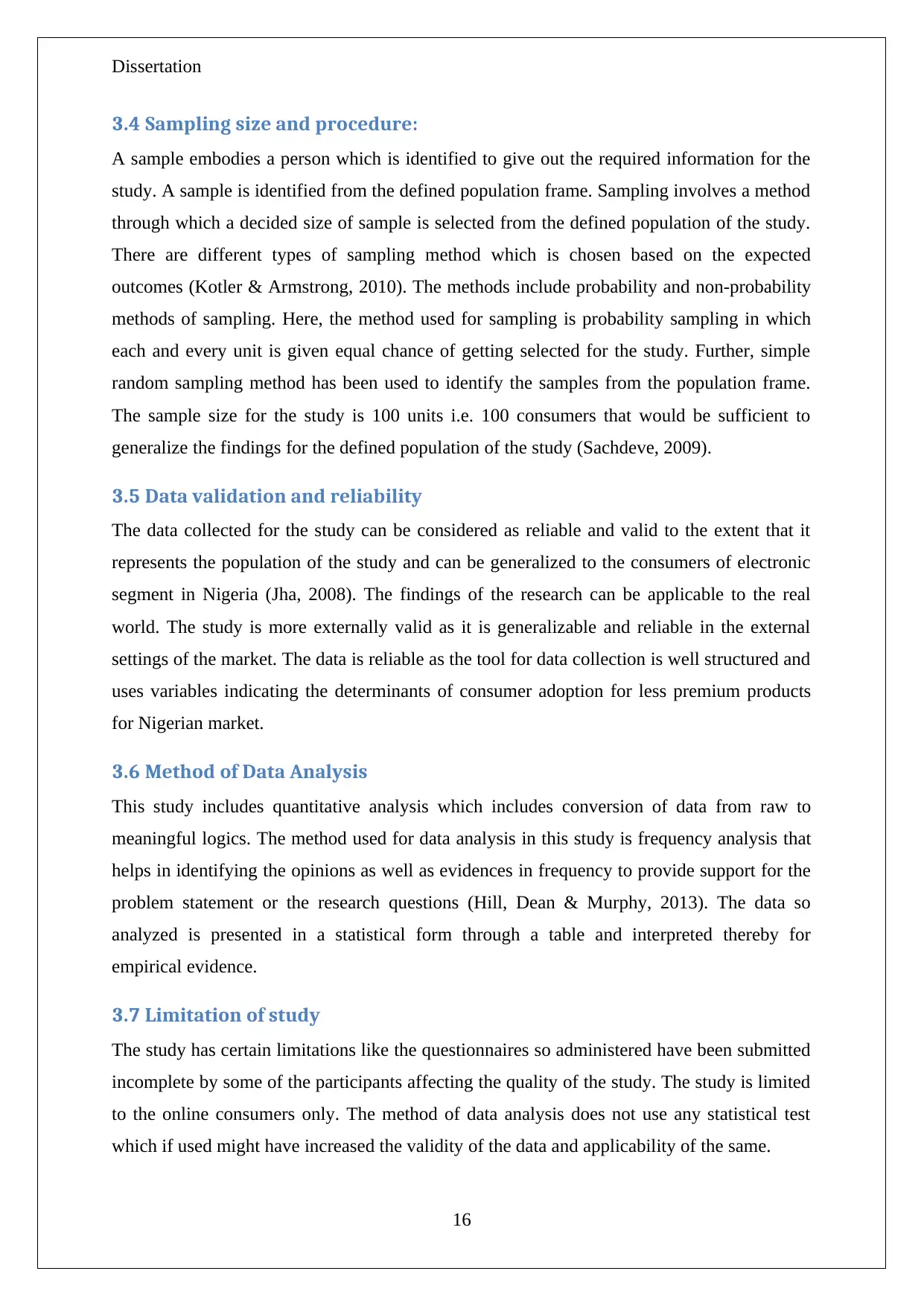
Dissertation
3.4 Sampling size and procedure:
A sample embodies a person which is identified to give out the required information for the
study. A sample is identified from the defined population frame. Sampling involves a method
through which a decided size of sample is selected from the defined population of the study.
There are different types of sampling method which is chosen based on the expected
outcomes (Kotler & Armstrong, 2010). The methods include probability and non-probability
methods of sampling. Here, the method used for sampling is probability sampling in which
each and every unit is given equal chance of getting selected for the study. Further, simple
random sampling method has been used to identify the samples from the population frame.
The sample size for the study is 100 units i.e. 100 consumers that would be sufficient to
generalize the findings for the defined population of the study (Sachdeve, 2009).
3.5 Data validation and reliability
The data collected for the study can be considered as reliable and valid to the extent that it
represents the population of the study and can be generalized to the consumers of electronic
segment in Nigeria (Jha, 2008). The findings of the research can be applicable to the real
world. The study is more externally valid as it is generalizable and reliable in the external
settings of the market. The data is reliable as the tool for data collection is well structured and
uses variables indicating the determinants of consumer adoption for less premium products
for Nigerian market.
3.6 Method of Data Analysis
This study includes quantitative analysis which includes conversion of data from raw to
meaningful logics. The method used for data analysis in this study is frequency analysis that
helps in identifying the opinions as well as evidences in frequency to provide support for the
problem statement or the research questions (Hill, Dean & Murphy, 2013). The data so
analyzed is presented in a statistical form through a table and interpreted thereby for
empirical evidence.
3.7 Limitation of study
The study has certain limitations like the questionnaires so administered have been submitted
incomplete by some of the participants affecting the quality of the study. The study is limited
to the online consumers only. The method of data analysis does not use any statistical test
which if used might have increased the validity of the data and applicability of the same.
16
3.4 Sampling size and procedure:
A sample embodies a person which is identified to give out the required information for the
study. A sample is identified from the defined population frame. Sampling involves a method
through which a decided size of sample is selected from the defined population of the study.
There are different types of sampling method which is chosen based on the expected
outcomes (Kotler & Armstrong, 2010). The methods include probability and non-probability
methods of sampling. Here, the method used for sampling is probability sampling in which
each and every unit is given equal chance of getting selected for the study. Further, simple
random sampling method has been used to identify the samples from the population frame.
The sample size for the study is 100 units i.e. 100 consumers that would be sufficient to
generalize the findings for the defined population of the study (Sachdeve, 2009).
3.5 Data validation and reliability
The data collected for the study can be considered as reliable and valid to the extent that it
represents the population of the study and can be generalized to the consumers of electronic
segment in Nigeria (Jha, 2008). The findings of the research can be applicable to the real
world. The study is more externally valid as it is generalizable and reliable in the external
settings of the market. The data is reliable as the tool for data collection is well structured and
uses variables indicating the determinants of consumer adoption for less premium products
for Nigerian market.
3.6 Method of Data Analysis
This study includes quantitative analysis which includes conversion of data from raw to
meaningful logics. The method used for data analysis in this study is frequency analysis that
helps in identifying the opinions as well as evidences in frequency to provide support for the
problem statement or the research questions (Hill, Dean & Murphy, 2013). The data so
analyzed is presented in a statistical form through a table and interpreted thereby for
empirical evidence.
3.7 Limitation of study
The study has certain limitations like the questionnaires so administered have been submitted
incomplete by some of the participants affecting the quality of the study. The study is limited
to the online consumers only. The method of data analysis does not use any statistical test
which if used might have increased the validity of the data and applicability of the same.
16
Secure Best Marks with AI Grader
Need help grading? Try our AI Grader for instant feedback on your assignments.
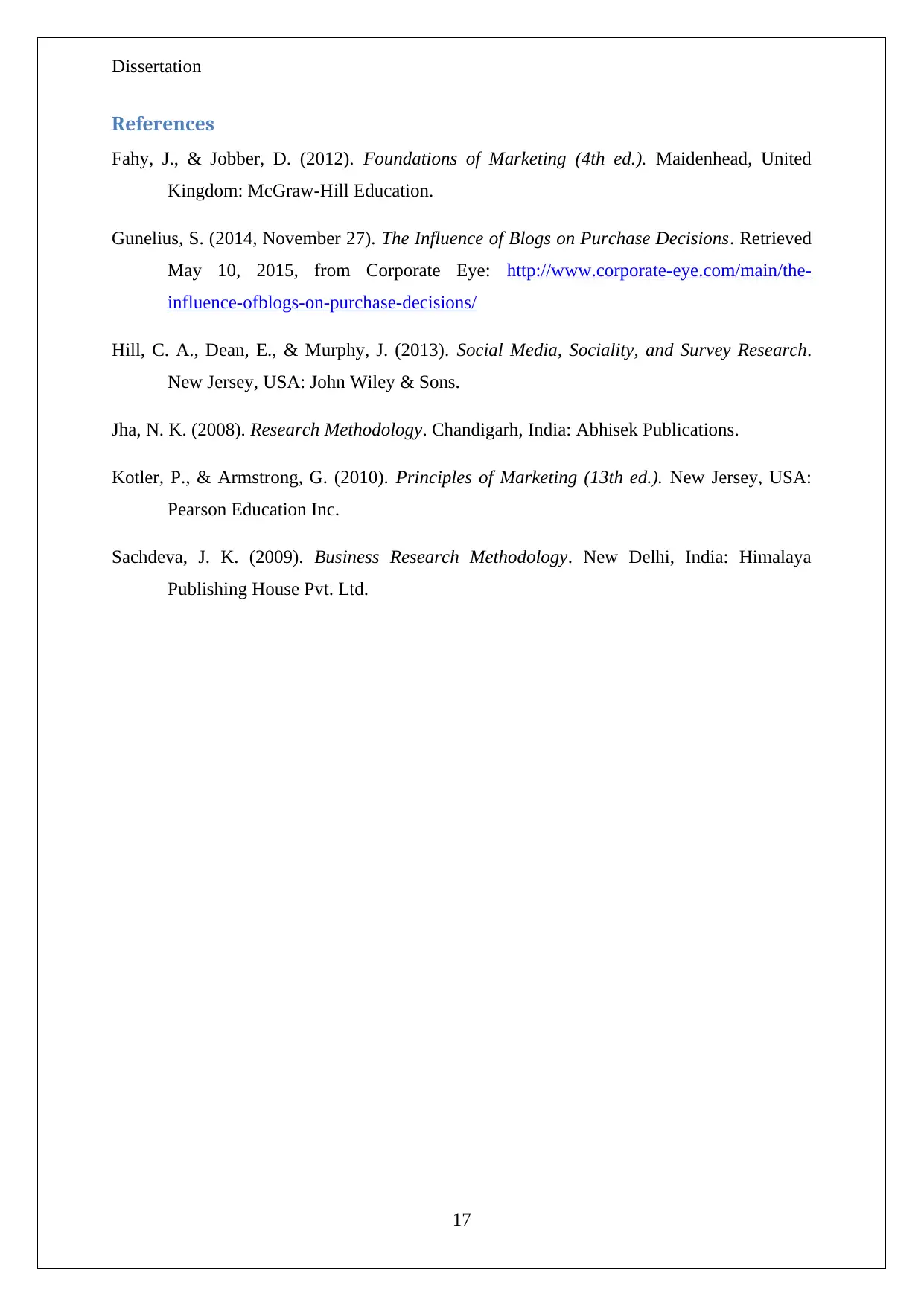
Dissertation
References
Fahy, J., & Jobber, D. (2012). Foundations of Marketing (4th ed.). Maidenhead, United
Kingdom: McGraw-Hill Education.
Gunelius, S. (2014, November 27). The Influence of Blogs on Purchase Decisions. Retrieved
May 10, 2015, from Corporate Eye: http://www.corporate-eye.com/main/the-
influence-ofblogs-on-purchase-decisions/
Hill, C. A., Dean, E., & Murphy, J. (2013). Social Media, Sociality, and Survey Research.
New Jersey, USA: John Wiley & Sons.
Jha, N. K. (2008). Research Methodology. Chandigarh, India: Abhisek Publications.
Kotler, P., & Armstrong, G. (2010). Principles of Marketing (13th ed.). New Jersey, USA:
Pearson Education Inc.
Sachdeva, J. K. (2009). Business Research Methodology. New Delhi, India: Himalaya
Publishing House Pvt. Ltd.
17
References
Fahy, J., & Jobber, D. (2012). Foundations of Marketing (4th ed.). Maidenhead, United
Kingdom: McGraw-Hill Education.
Gunelius, S. (2014, November 27). The Influence of Blogs on Purchase Decisions. Retrieved
May 10, 2015, from Corporate Eye: http://www.corporate-eye.com/main/the-
influence-ofblogs-on-purchase-decisions/
Hill, C. A., Dean, E., & Murphy, J. (2013). Social Media, Sociality, and Survey Research.
New Jersey, USA: John Wiley & Sons.
Jha, N. K. (2008). Research Methodology. Chandigarh, India: Abhisek Publications.
Kotler, P., & Armstrong, G. (2010). Principles of Marketing (13th ed.). New Jersey, USA:
Pearson Education Inc.
Sachdeva, J. K. (2009). Business Research Methodology. New Delhi, India: Himalaya
Publishing House Pvt. Ltd.
17

Dissertation
Chapter Four- Data Presentation and Analysis
4.1 Preamble
This chapter analyzes and presents the data collected through the questionnaire through
online medium from 100 Nigerian consumers. The data has been analyzed through a
frequency measurement and presented through a data table followed by the interpretation of
the same.
4.2 Data analysis
Age 20-29 30-39 40-49
30% 40% 30%
Income class Lower Middle Higher
25% 45% 30%
Yes No
Do you own
Hisense
electronic
products?
30% 70%
Does price
affect your
buying decision
for a product?
70% 30%
Does your
income affect
your buying
decision for a
product?
80% 20%
Is social
belonging an
30% 70%
18
Chapter Four- Data Presentation and Analysis
4.1 Preamble
This chapter analyzes and presents the data collected through the questionnaire through
online medium from 100 Nigerian consumers. The data has been analyzed through a
frequency measurement and presented through a data table followed by the interpretation of
the same.
4.2 Data analysis
Age 20-29 30-39 40-49
30% 40% 30%
Income class Lower Middle Higher
25% 45% 30%
Yes No
Do you own
Hisense
electronic
products?
30% 70%
Does price
affect your
buying decision
for a product?
70% 30%
Does your
income affect
your buying
decision for a
product?
80% 20%
Is social
belonging an
30% 70%
18
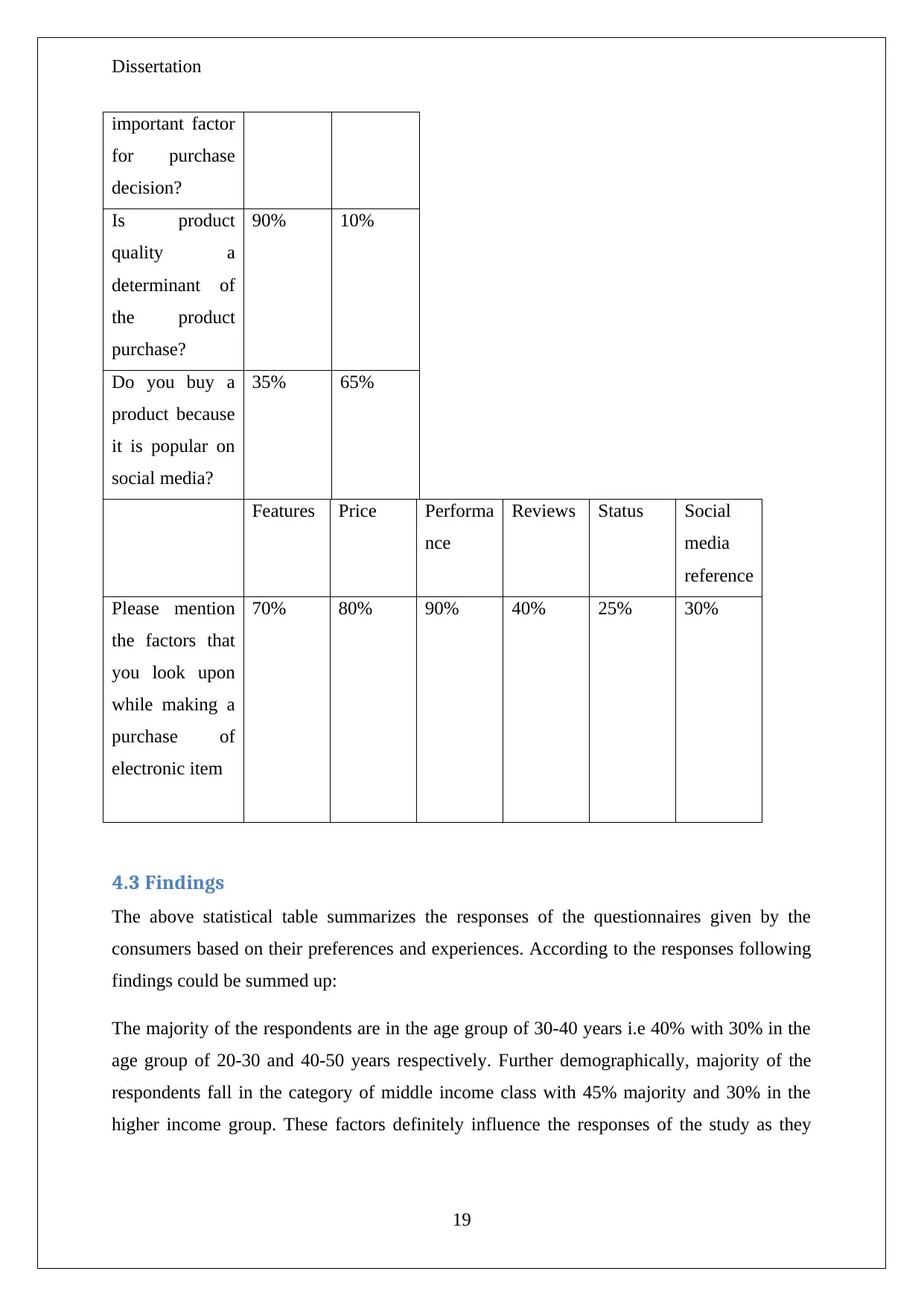
Dissertation
important factor
for purchase
decision?
Is product
quality a
determinant of
the product
purchase?
90% 10%
Do you buy a
product because
it is popular on
social media?
35% 65%
Features Price Performa
nce
Reviews Status Social
media
reference
Please mention
the factors that
you look upon
while making a
purchase of
electronic item
70% 80% 90% 40% 25% 30%
4.3 Findings
The above statistical table summarizes the responses of the questionnaires given by the
consumers based on their preferences and experiences. According to the responses following
findings could be summed up:
The majority of the respondents are in the age group of 30-40 years i.e 40% with 30% in the
age group of 20-30 and 40-50 years respectively. Further demographically, majority of the
respondents fall in the category of middle income class with 45% majority and 30% in the
higher income group. These factors definitely influence the responses of the study as they
19
important factor
for purchase
decision?
Is product
quality a
determinant of
the product
purchase?
90% 10%
Do you buy a
product because
it is popular on
social media?
35% 65%
Features Price Performa
nce
Reviews Status Social
media
reference
Please mention
the factors that
you look upon
while making a
purchase of
electronic item
70% 80% 90% 40% 25% 30%
4.3 Findings
The above statistical table summarizes the responses of the questionnaires given by the
consumers based on their preferences and experiences. According to the responses following
findings could be summed up:
The majority of the respondents are in the age group of 30-40 years i.e 40% with 30% in the
age group of 20-30 and 40-50 years respectively. Further demographically, majority of the
respondents fall in the category of middle income class with 45% majority and 30% in the
higher income group. These factors definitely influence the responses of the study as they
19
Paraphrase This Document
Need a fresh take? Get an instant paraphrase of this document with our AI Paraphraser
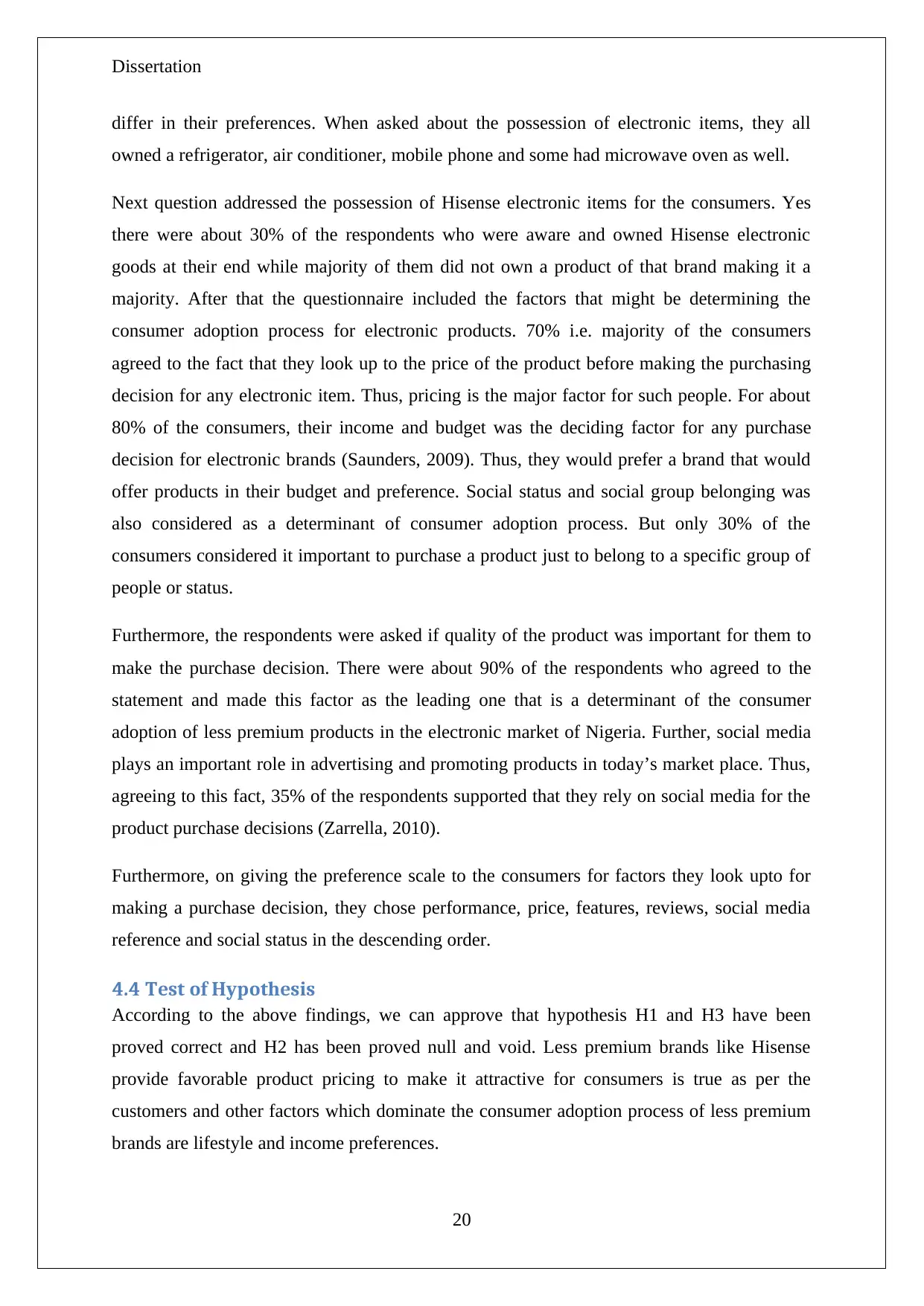
Dissertation
differ in their preferences. When asked about the possession of electronic items, they all
owned a refrigerator, air conditioner, mobile phone and some had microwave oven as well.
Next question addressed the possession of Hisense electronic items for the consumers. Yes
there were about 30% of the respondents who were aware and owned Hisense electronic
goods at their end while majority of them did not own a product of that brand making it a
majority. After that the questionnaire included the factors that might be determining the
consumer adoption process for electronic products. 70% i.e. majority of the consumers
agreed to the fact that they look up to the price of the product before making the purchasing
decision for any electronic item. Thus, pricing is the major factor for such people. For about
80% of the consumers, their income and budget was the deciding factor for any purchase
decision for electronic brands (Saunders, 2009). Thus, they would prefer a brand that would
offer products in their budget and preference. Social status and social group belonging was
also considered as a determinant of consumer adoption process. But only 30% of the
consumers considered it important to purchase a product just to belong to a specific group of
people or status.
Furthermore, the respondents were asked if quality of the product was important for them to
make the purchase decision. There were about 90% of the respondents who agreed to the
statement and made this factor as the leading one that is a determinant of the consumer
adoption of less premium products in the electronic market of Nigeria. Further, social media
plays an important role in advertising and promoting products in today’s market place. Thus,
agreeing to this fact, 35% of the respondents supported that they rely on social media for the
product purchase decisions (Zarrella, 2010).
Furthermore, on giving the preference scale to the consumers for factors they look upto for
making a purchase decision, they chose performance, price, features, reviews, social media
reference and social status in the descending order.
4.4 Test of Hypothesis
According to the above findings, we can approve that hypothesis H1 and H3 have been
proved correct and H2 has been proved null and void. Less premium brands like Hisense
provide favorable product pricing to make it attractive for consumers is true as per the
customers and other factors which dominate the consumer adoption process of less premium
brands are lifestyle and income preferences.
20
differ in their preferences. When asked about the possession of electronic items, they all
owned a refrigerator, air conditioner, mobile phone and some had microwave oven as well.
Next question addressed the possession of Hisense electronic items for the consumers. Yes
there were about 30% of the respondents who were aware and owned Hisense electronic
goods at their end while majority of them did not own a product of that brand making it a
majority. After that the questionnaire included the factors that might be determining the
consumer adoption process for electronic products. 70% i.e. majority of the consumers
agreed to the fact that they look up to the price of the product before making the purchasing
decision for any electronic item. Thus, pricing is the major factor for such people. For about
80% of the consumers, their income and budget was the deciding factor for any purchase
decision for electronic brands (Saunders, 2009). Thus, they would prefer a brand that would
offer products in their budget and preference. Social status and social group belonging was
also considered as a determinant of consumer adoption process. But only 30% of the
consumers considered it important to purchase a product just to belong to a specific group of
people or status.
Furthermore, the respondents were asked if quality of the product was important for them to
make the purchase decision. There were about 90% of the respondents who agreed to the
statement and made this factor as the leading one that is a determinant of the consumer
adoption of less premium products in the electronic market of Nigeria. Further, social media
plays an important role in advertising and promoting products in today’s market place. Thus,
agreeing to this fact, 35% of the respondents supported that they rely on social media for the
product purchase decisions (Zarrella, 2010).
Furthermore, on giving the preference scale to the consumers for factors they look upto for
making a purchase decision, they chose performance, price, features, reviews, social media
reference and social status in the descending order.
4.4 Test of Hypothesis
According to the above findings, we can approve that hypothesis H1 and H3 have been
proved correct and H2 has been proved null and void. Less premium brands like Hisense
provide favorable product pricing to make it attractive for consumers is true as per the
customers and other factors which dominate the consumer adoption process of less premium
brands are lifestyle and income preferences.
20

Dissertation
21
21

Dissertation
References
Saunders, M., Lewis, P., & Thornhill, A. (2009). Research Methods for Business Students
(5th ed.). Essex, England: Prentice Hall.
Zarrella, D. (2010). The Social Media Marketing Book. CA, USA: O'Reilly Media.
22
References
Saunders, M., Lewis, P., & Thornhill, A. (2009). Research Methods for Business Students
(5th ed.). Essex, England: Prentice Hall.
Zarrella, D. (2010). The Social Media Marketing Book. CA, USA: O'Reilly Media.
22
Secure Best Marks with AI Grader
Need help grading? Try our AI Grader for instant feedback on your assignments.
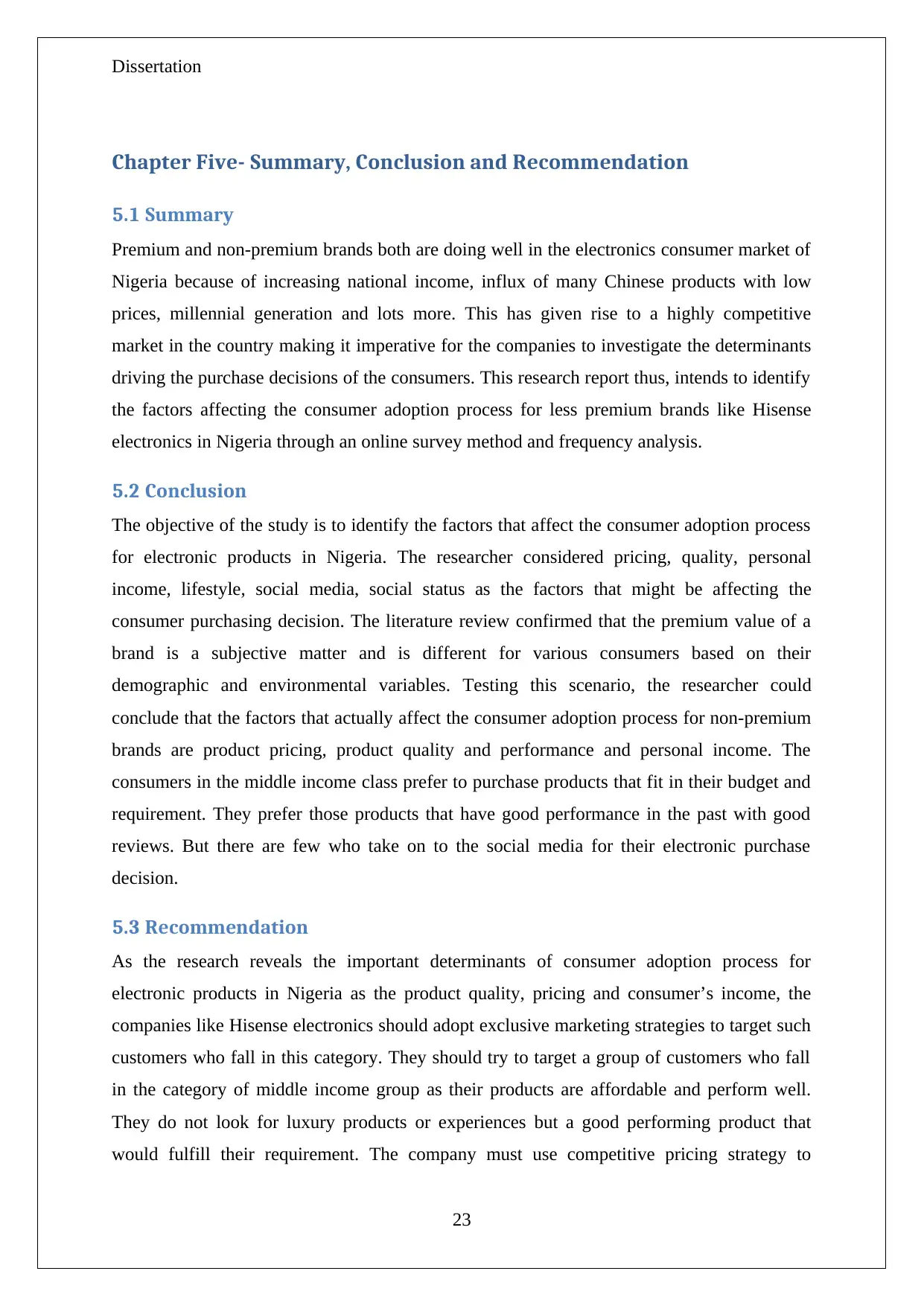
Dissertation
Chapter Five- Summary, Conclusion and Recommendation
5.1 Summary
Premium and non-premium brands both are doing well in the electronics consumer market of
Nigeria because of increasing national income, influx of many Chinese products with low
prices, millennial generation and lots more. This has given rise to a highly competitive
market in the country making it imperative for the companies to investigate the determinants
driving the purchase decisions of the consumers. This research report thus, intends to identify
the factors affecting the consumer adoption process for less premium brands like Hisense
electronics in Nigeria through an online survey method and frequency analysis.
5.2 Conclusion
The objective of the study is to identify the factors that affect the consumer adoption process
for electronic products in Nigeria. The researcher considered pricing, quality, personal
income, lifestyle, social media, social status as the factors that might be affecting the
consumer purchasing decision. The literature review confirmed that the premium value of a
brand is a subjective matter and is different for various consumers based on their
demographic and environmental variables. Testing this scenario, the researcher could
conclude that the factors that actually affect the consumer adoption process for non-premium
brands are product pricing, product quality and performance and personal income. The
consumers in the middle income class prefer to purchase products that fit in their budget and
requirement. They prefer those products that have good performance in the past with good
reviews. But there are few who take on to the social media for their electronic purchase
decision.
5.3 Recommendation
As the research reveals the important determinants of consumer adoption process for
electronic products in Nigeria as the product quality, pricing and consumer’s income, the
companies like Hisense electronics should adopt exclusive marketing strategies to target such
customers who fall in this category. They should try to target a group of customers who fall
in the category of middle income group as their products are affordable and perform well.
They do not look for luxury products or experiences but a good performing product that
would fulfill their requirement. The company must use competitive pricing strategy to
23
Chapter Five- Summary, Conclusion and Recommendation
5.1 Summary
Premium and non-premium brands both are doing well in the electronics consumer market of
Nigeria because of increasing national income, influx of many Chinese products with low
prices, millennial generation and lots more. This has given rise to a highly competitive
market in the country making it imperative for the companies to investigate the determinants
driving the purchase decisions of the consumers. This research report thus, intends to identify
the factors affecting the consumer adoption process for less premium brands like Hisense
electronics in Nigeria through an online survey method and frequency analysis.
5.2 Conclusion
The objective of the study is to identify the factors that affect the consumer adoption process
for electronic products in Nigeria. The researcher considered pricing, quality, personal
income, lifestyle, social media, social status as the factors that might be affecting the
consumer purchasing decision. The literature review confirmed that the premium value of a
brand is a subjective matter and is different for various consumers based on their
demographic and environmental variables. Testing this scenario, the researcher could
conclude that the factors that actually affect the consumer adoption process for non-premium
brands are product pricing, product quality and performance and personal income. The
consumers in the middle income class prefer to purchase products that fit in their budget and
requirement. They prefer those products that have good performance in the past with good
reviews. But there are few who take on to the social media for their electronic purchase
decision.
5.3 Recommendation
As the research reveals the important determinants of consumer adoption process for
electronic products in Nigeria as the product quality, pricing and consumer’s income, the
companies like Hisense electronics should adopt exclusive marketing strategies to target such
customers who fall in this category. They should try to target a group of customers who fall
in the category of middle income group as their products are affordable and perform well.
They do not look for luxury products or experiences but a good performing product that
would fulfill their requirement. The company must use competitive pricing strategy to
23
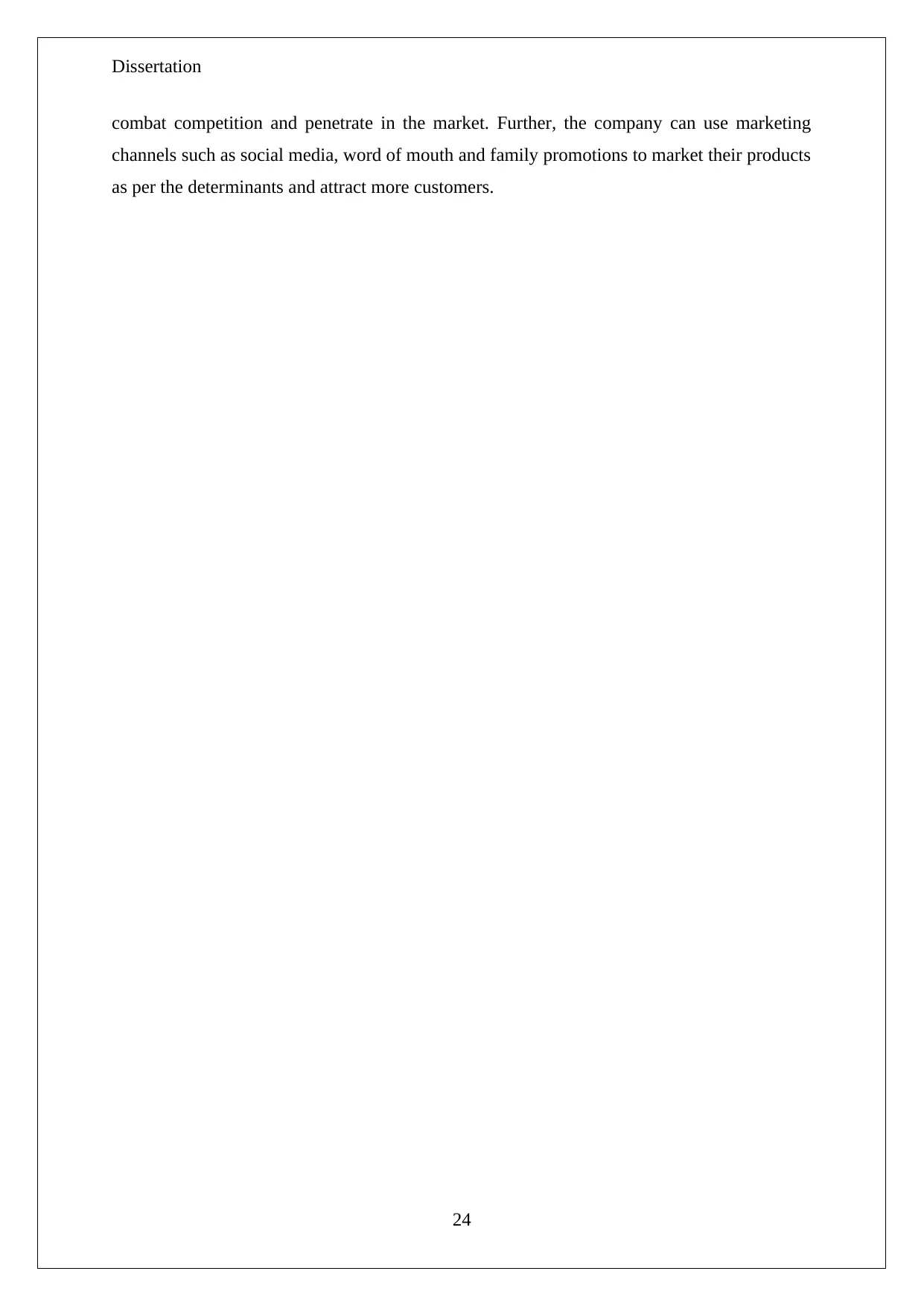
Dissertation
combat competition and penetrate in the market. Further, the company can use marketing
channels such as social media, word of mouth and family promotions to market their products
as per the determinants and attract more customers.
24
combat competition and penetrate in the market. Further, the company can use marketing
channels such as social media, word of mouth and family promotions to market their products
as per the determinants and attract more customers.
24
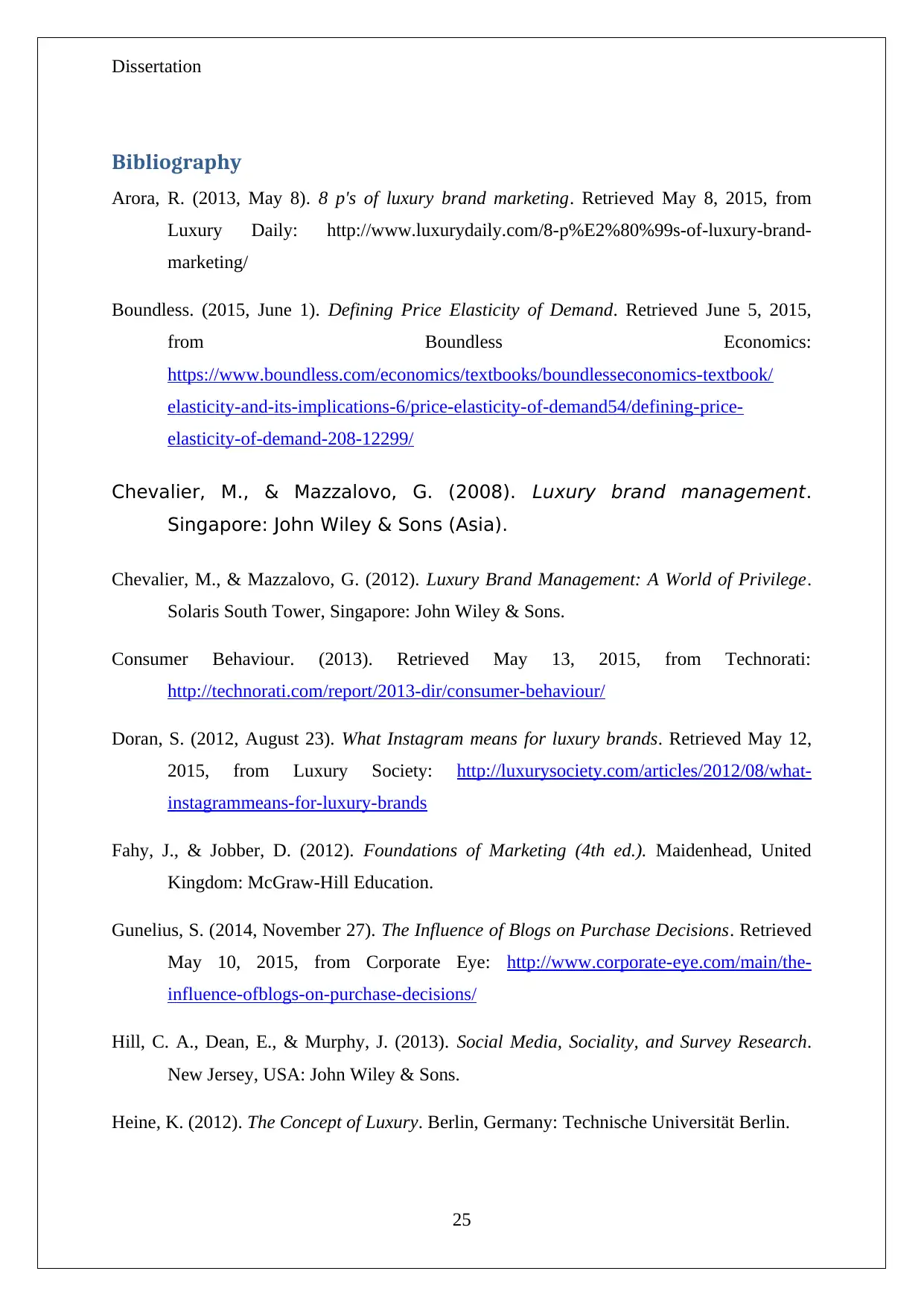
Dissertation
Bibliography
Arora, R. (2013, May 8). 8 p's of luxury brand marketing. Retrieved May 8, 2015, from
Luxury Daily: http://www.luxurydaily.com/8-p%E2%80%99s-of-luxury-brand-
marketing/
Boundless. (2015, June 1). Defining Price Elasticity of Demand. Retrieved June 5, 2015,
from Boundless Economics:
https://www.boundless.com/economics/textbooks/boundlesseconomics-textbook/
elasticity-and-its-implications-6/price-elasticity-of-demand54/defining-price-
elasticity-of-demand-208-12299/
Chevalier, M., & Mazzalovo, G. (2008). Luxury brand management.
Singapore: John Wiley & Sons (Asia).
Chevalier, M., & Mazzalovo, G. (2012). Luxury Brand Management: A World of Privilege.
Solaris South Tower, Singapore: John Wiley & Sons.
Consumer Behaviour. (2013). Retrieved May 13, 2015, from Technorati:
http://technorati.com/report/2013-dir/consumer-behaviour/
Doran, S. (2012, August 23). What Instagram means for luxury brands. Retrieved May 12,
2015, from Luxury Society: http://luxurysociety.com/articles/2012/08/what-
instagrammeans-for-luxury-brands
Fahy, J., & Jobber, D. (2012). Foundations of Marketing (4th ed.). Maidenhead, United
Kingdom: McGraw-Hill Education.
Gunelius, S. (2014, November 27). The Influence of Blogs on Purchase Decisions. Retrieved
May 10, 2015, from Corporate Eye: http://www.corporate-eye.com/main/the-
influence-ofblogs-on-purchase-decisions/
Hill, C. A., Dean, E., & Murphy, J. (2013). Social Media, Sociality, and Survey Research.
New Jersey, USA: John Wiley & Sons.
Heine, K. (2012). The Concept of Luxury. Berlin, Germany: Technische Universität Berlin.
25
Bibliography
Arora, R. (2013, May 8). 8 p's of luxury brand marketing. Retrieved May 8, 2015, from
Luxury Daily: http://www.luxurydaily.com/8-p%E2%80%99s-of-luxury-brand-
marketing/
Boundless. (2015, June 1). Defining Price Elasticity of Demand. Retrieved June 5, 2015,
from Boundless Economics:
https://www.boundless.com/economics/textbooks/boundlesseconomics-textbook/
elasticity-and-its-implications-6/price-elasticity-of-demand54/defining-price-
elasticity-of-demand-208-12299/
Chevalier, M., & Mazzalovo, G. (2008). Luxury brand management.
Singapore: John Wiley & Sons (Asia).
Chevalier, M., & Mazzalovo, G. (2012). Luxury Brand Management: A World of Privilege.
Solaris South Tower, Singapore: John Wiley & Sons.
Consumer Behaviour. (2013). Retrieved May 13, 2015, from Technorati:
http://technorati.com/report/2013-dir/consumer-behaviour/
Doran, S. (2012, August 23). What Instagram means for luxury brands. Retrieved May 12,
2015, from Luxury Society: http://luxurysociety.com/articles/2012/08/what-
instagrammeans-for-luxury-brands
Fahy, J., & Jobber, D. (2012). Foundations of Marketing (4th ed.). Maidenhead, United
Kingdom: McGraw-Hill Education.
Gunelius, S. (2014, November 27). The Influence of Blogs on Purchase Decisions. Retrieved
May 10, 2015, from Corporate Eye: http://www.corporate-eye.com/main/the-
influence-ofblogs-on-purchase-decisions/
Hill, C. A., Dean, E., & Murphy, J. (2013). Social Media, Sociality, and Survey Research.
New Jersey, USA: John Wiley & Sons.
Heine, K. (2012). The Concept of Luxury. Berlin, Germany: Technische Universität Berlin.
25
Paraphrase This Document
Need a fresh take? Get an instant paraphrase of this document with our AI Paraphraser
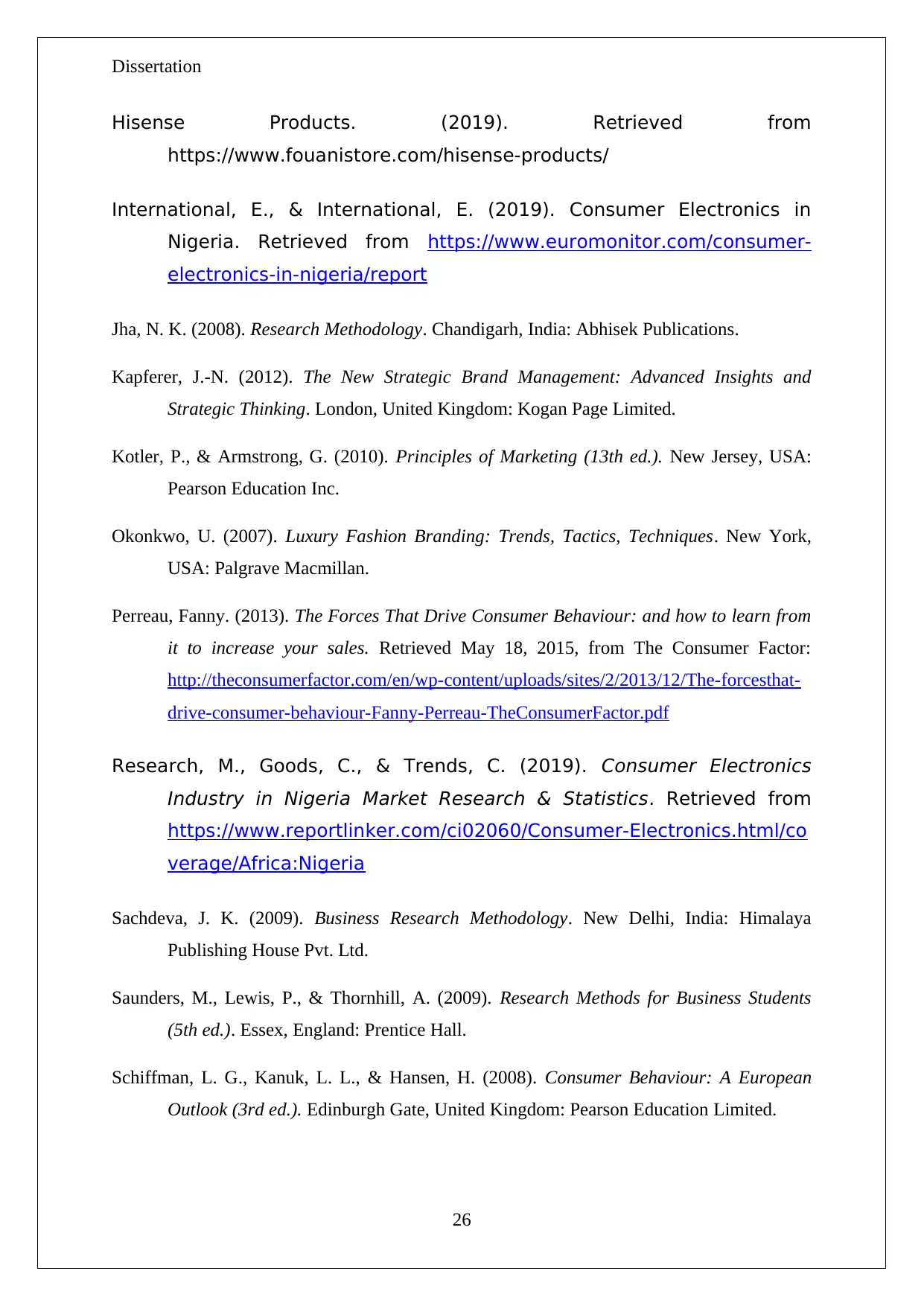
Dissertation
Hisense Products. (2019). Retrieved from
https://www.fouanistore.com/hisense-products/
International, E., & International, E. (2019). Consumer Electronics in
Nigeria. Retrieved from https://www.euromonitor.com/consumer-
electronics-in-nigeria/report
Jha, N. K. (2008). Research Methodology. Chandigarh, India: Abhisek Publications.
Kapferer, J.-N. (2012). The New Strategic Brand Management: Advanced Insights and
Strategic Thinking. London, United Kingdom: Kogan Page Limited.
Kotler, P., & Armstrong, G. (2010). Principles of Marketing (13th ed.). New Jersey, USA:
Pearson Education Inc.
Okonkwo, U. (2007). Luxury Fashion Branding: Trends, Tactics, Techniques. New York,
USA: Palgrave Macmillan.
Perreau, Fanny. (2013). The Forces That Drive Consumer Behaviour: and how to learn from
it to increase your sales. Retrieved May 18, 2015, from The Consumer Factor:
http://theconsumerfactor.com/en/wp-content/uploads/sites/2/2013/12/The-forcesthat-
drive-consumer-behaviour-Fanny-Perreau-TheConsumerFactor.pdf
Research, M., Goods, C., & Trends, C. (2019). Consumer Electronics
Industry in Nigeria Market Research & Statistics. Retrieved from
https://www.reportlinker.com/ci02060/Consumer-Electronics.html/co
verage/Africa:Nigeria
Sachdeva, J. K. (2009). Business Research Methodology. New Delhi, India: Himalaya
Publishing House Pvt. Ltd.
Saunders, M., Lewis, P., & Thornhill, A. (2009). Research Methods for Business Students
(5th ed.). Essex, England: Prentice Hall.
Schiffman, L. G., Kanuk, L. L., & Hansen, H. (2008). Consumer Behaviour: A European
Outlook (3rd ed.). Edinburgh Gate, United Kingdom: Pearson Education Limited.
26
Hisense Products. (2019). Retrieved from
https://www.fouanistore.com/hisense-products/
International, E., & International, E. (2019). Consumer Electronics in
Nigeria. Retrieved from https://www.euromonitor.com/consumer-
electronics-in-nigeria/report
Jha, N. K. (2008). Research Methodology. Chandigarh, India: Abhisek Publications.
Kapferer, J.-N. (2012). The New Strategic Brand Management: Advanced Insights and
Strategic Thinking. London, United Kingdom: Kogan Page Limited.
Kotler, P., & Armstrong, G. (2010). Principles of Marketing (13th ed.). New Jersey, USA:
Pearson Education Inc.
Okonkwo, U. (2007). Luxury Fashion Branding: Trends, Tactics, Techniques. New York,
USA: Palgrave Macmillan.
Perreau, Fanny. (2013). The Forces That Drive Consumer Behaviour: and how to learn from
it to increase your sales. Retrieved May 18, 2015, from The Consumer Factor:
http://theconsumerfactor.com/en/wp-content/uploads/sites/2/2013/12/The-forcesthat-
drive-consumer-behaviour-Fanny-Perreau-TheConsumerFactor.pdf
Research, M., Goods, C., & Trends, C. (2019). Consumer Electronics
Industry in Nigeria Market Research & Statistics. Retrieved from
https://www.reportlinker.com/ci02060/Consumer-Electronics.html/co
verage/Africa:Nigeria
Sachdeva, J. K. (2009). Business Research Methodology. New Delhi, India: Himalaya
Publishing House Pvt. Ltd.
Saunders, M., Lewis, P., & Thornhill, A. (2009). Research Methods for Business Students
(5th ed.). Essex, England: Prentice Hall.
Schiffman, L. G., Kanuk, L. L., & Hansen, H. (2008). Consumer Behaviour: A European
Outlook (3rd ed.). Edinburgh Gate, United Kingdom: Pearson Education Limited.
26

Dissertation
Scholz, L. M. (2014). Brand Management and Marketing of Luxury Goods. Hamburg,
Germany: Anchor Academic Publishing.
Zarrella, D. (2010). The Social Media Marketing Book. CA, USA: O'Reilly Media.
27
Scholz, L. M. (2014). Brand Management and Marketing of Luxury Goods. Hamburg,
Germany: Anchor Academic Publishing.
Zarrella, D. (2010). The Social Media Marketing Book. CA, USA: O'Reilly Media.
27

Dissertation
Appendix
Questionnaire:
1. Age-
20-29
30-39
40-49
2. Income class-
Lower class
Middle class
Higher class
3. Which electronic items do you own?
Microwave oven
Mobile phone
Refrigerator
Air conditioner
Others
4. Do you own Hisense electronic products?
Yes
No
5. Does price affect your buying decision for a product?
Yes
No
28
Appendix
Questionnaire:
1. Age-
20-29
30-39
40-49
2. Income class-
Lower class
Middle class
Higher class
3. Which electronic items do you own?
Microwave oven
Mobile phone
Refrigerator
Air conditioner
Others
4. Do you own Hisense electronic products?
Yes
No
5. Does price affect your buying decision for a product?
Yes
No
28
Secure Best Marks with AI Grader
Need help grading? Try our AI Grader for instant feedback on your assignments.
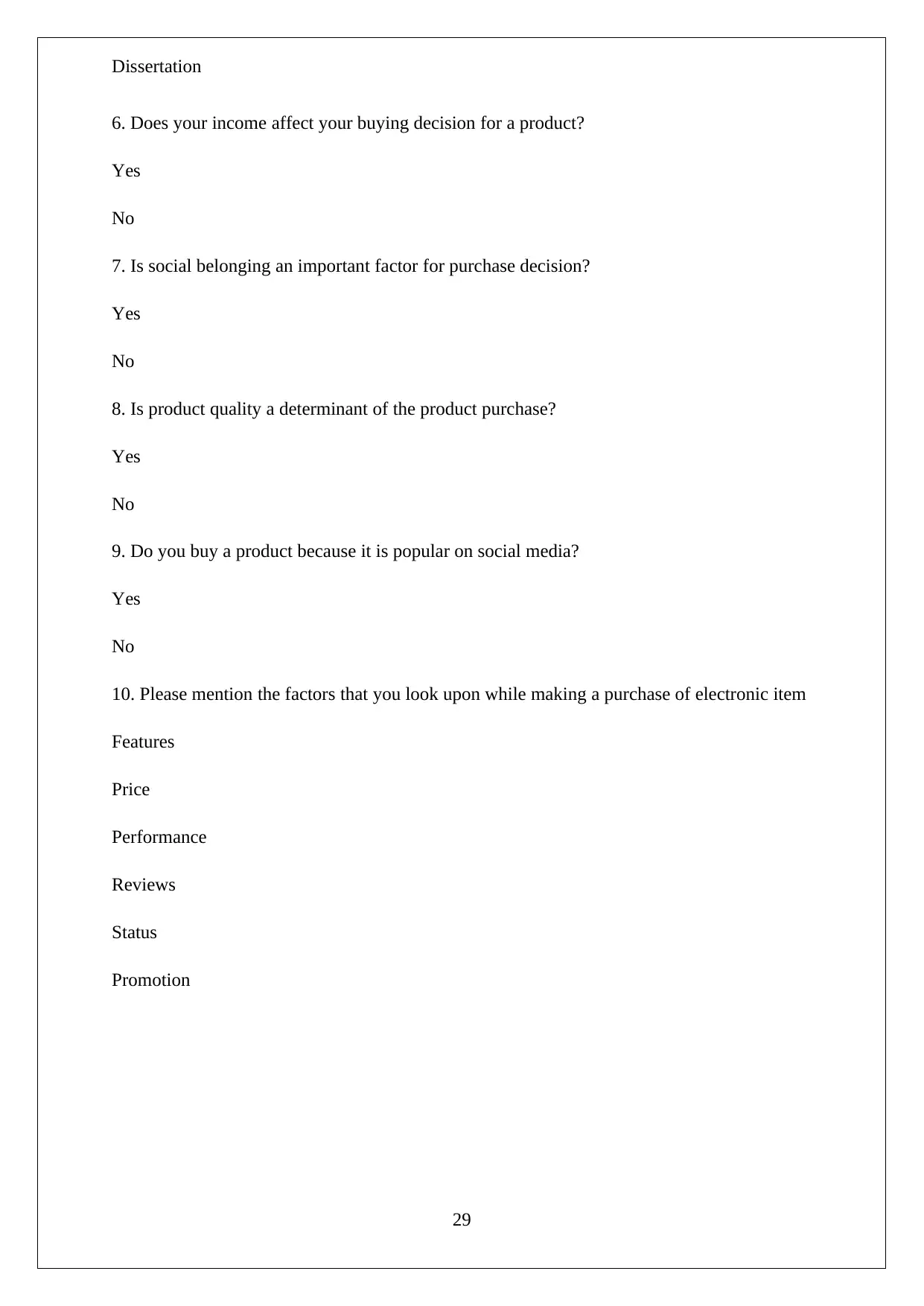
Dissertation
6. Does your income affect your buying decision for a product?
Yes
No
7. Is social belonging an important factor for purchase decision?
Yes
No
8. Is product quality a determinant of the product purchase?
Yes
No
9. Do you buy a product because it is popular on social media?
Yes
No
10. Please mention the factors that you look upon while making a purchase of electronic item
Features
Price
Performance
Reviews
Status
Promotion
29
6. Does your income affect your buying decision for a product?
Yes
No
7. Is social belonging an important factor for purchase decision?
Yes
No
8. Is product quality a determinant of the product purchase?
Yes
No
9. Do you buy a product because it is popular on social media?
Yes
No
10. Please mention the factors that you look upon while making a purchase of electronic item
Features
Price
Performance
Reviews
Status
Promotion
29
1 out of 29
Related Documents
Your All-in-One AI-Powered Toolkit for Academic Success.
+13062052269
info@desklib.com
Available 24*7 on WhatsApp / Email
![[object Object]](/_next/static/media/star-bottom.7253800d.svg)
Unlock your academic potential
© 2024 | Zucol Services PVT LTD | All rights reserved.





